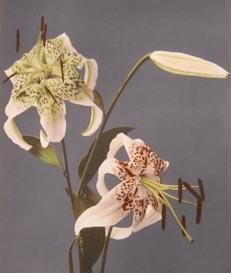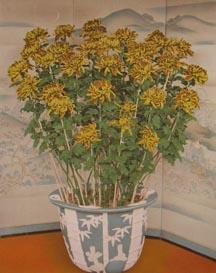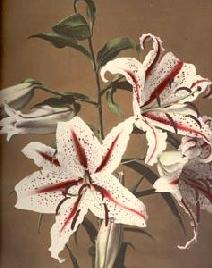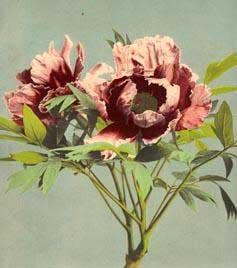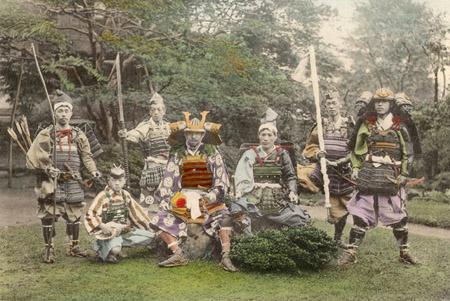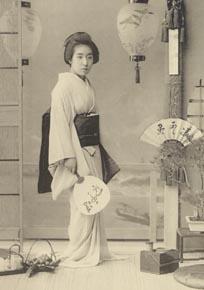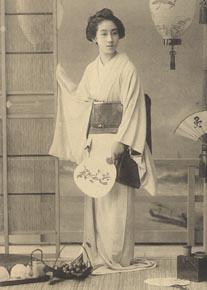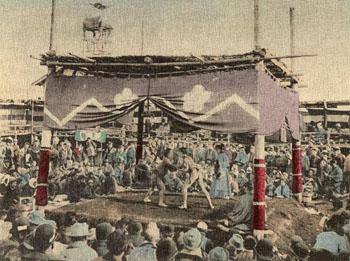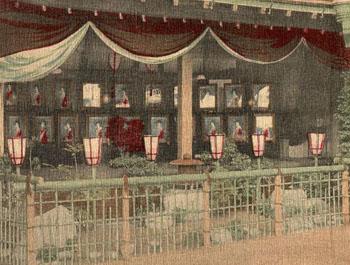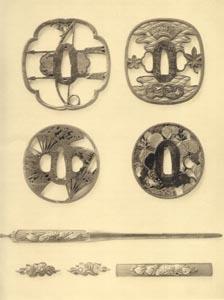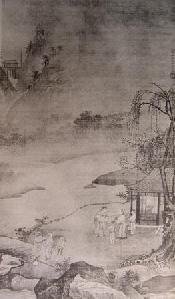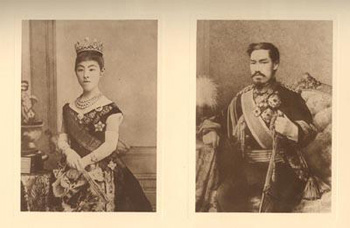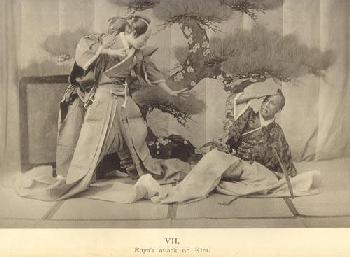 Ogawa Kazumasa (aka Kazuma or Isshin) (1860-1929) is considered a pioneer in the development of photography and photomechanical printing in Japan. In 1882~4 Ogawa studied portrait photography and the dry plate process in Boston. He also studied collotype printing with the Albert Type Company. On his return to Japan in 1884 he opened a photographic studio in Tokyo. In 1888 he established Tsukiji Kampan Seizo Kaisha (Tsukiji Dry Plate Manufacturing Company) which manufactured dry plates for use by photographers. This business failed after several years in operation. In 1889 he started Japan's first photoengraving business, the Ogawa Shashin Seihan-jo (Ogawa Photograph (Plate) Making Shop). This is sometimes referred to as the K. Ogawa printing factory, No. 11, Yanagimara, Tokyo. This business started with manufacturing half-tone plates and by 1894 added collotype printing. Ogawa published/distributed under the name Ogawa Shashin Seihan-jo and Ogawa Shuppanbu. In the early 1890s, Ogawa incorporated the copper type printing process with the collotype process thereby making it possible to print descriptive titles on the same plate with the collotype image. Ogawa Kazumasa (aka Kazuma or Isshin) (1860-1929) is considered a pioneer in the development of photography and photomechanical printing in Japan. In 1882~4 Ogawa studied portrait photography and the dry plate process in Boston. He also studied collotype printing with the Albert Type Company. On his return to Japan in 1884 he opened a photographic studio in Tokyo. In 1888 he established Tsukiji Kampan Seizo Kaisha (Tsukiji Dry Plate Manufacturing Company) which manufactured dry plates for use by photographers. This business failed after several years in operation. In 1889 he started Japan's first photoengraving business, the Ogawa Shashin Seihan-jo (Ogawa Photograph (Plate) Making Shop). This is sometimes referred to as the K. Ogawa printing factory, No. 11, Yanagimara, Tokyo. This business started with manufacturing half-tone plates and by 1894 added collotype printing. Ogawa published/distributed under the name Ogawa Shashin Seihan-jo and Ogawa Shuppanbu. In the early 1890s, Ogawa incorporated the copper type printing process with the collotype process thereby making it possible to print descriptive titles on the same plate with the collotype image.
Beginning in 1889 he served as the editor of the Shashin Shimpo (East Asia's first and Japan's only photographic journal at the time) and Kokka ("National Essence") magazine and printed both using collotype printing for the plates. He served as the editor of the Shashin Shimpo from 1889 to 1894. He was a founding member (1889) of the Nihon Sashinkai (Japan Photographic Society), Japan's first amateur photography association.
Ogawa's contribution to an understanding of Meiji era Japan, which was just then emerging from hundreds of years of seclusion, by the Western world is incalculable. Many photographers were at work in Japan during this period recording views of Meiji Japan and marketing them on a limited basis. Kazumasa Ogawa went far beyond that type of enterprise. Not only was he an accomplished photographer, he was a visionary printer and publisher. His work in printing brought these wonderful views to the public in large quantities (at least compared to individually produced albumen photographs) and at relatively low cost through the use collotype and other photomechanical printing processes. We are indeed indebted to Kazumasa Ogawa for his pioneering work in Japan in this area. The books you will see listed below are a testament to his expertise and just a trace of the fruits of his labors. While Commodore M. C. Perry opened Japan to the outside world in 1854, in the years that followed Kazumasa Ogawa put the country on display for all the world to see and appreciate.
Ogawa provided the large format color collotypes of flowers which are the frontispiece for the Frank Brinkley series, Japan, Described and Illustrated by the Japanese, Written By Eminent Japanese Authorities and Scholars. For information on these books, click here. Ogawa is renowned for the high quality of his color collotype printing and the multi-pass collotype process used to create the flower collotypes for the Brinkley books is the epitome of his work in this area. For more information on the multi-pass color collotype process (aka chromo-collotype), click here. To see all of the Ogawa color collotypes in the 15 section Brinkley books published in 1897~8, click here. In 1894 Anthony's Photographic Bulletin referred to Ogawa's collotype printing method as the "New School" and characterized by nothing in the print being as "sharp" as the camera lens can make it.
While Kazumasa Ogawa is probably best know for his work in books illustrated with collotype and half-tone prints, his photographic work encompassed a wide spectrum of processes and formats including ambrotypes, albumen prints, platinotype prints, cabinet cards, carte de visite and stereoviews.
The University of Nagasaki has a database which contains 400+ photographs attributed to K. (Kazumasa) Ogawa. To see the Ogawa pictures in the database, click here. Photographs of this nature were often assembled into albums sold to tourists (tourist albums). While K. Ogawa worked with albumen photographs and operated several photography studios, it appears that this effort was only a small part of his enterprises.
Through his Photographic Studio business (Gyokujun-kan) ( ) Ogawa offered portrait photographs and other similar type products. It is my experience that his studio type work executed for individual customers is seldom seen. To see a "cabinet card" portrait of a Westerner produced by K. Ogawa, click here. A similar card produced by Ogawa but with a portrait of a Japanese man can be seen here.. There was a photograph studio operated by Sashichi Ogawa in Yokohama (Sakai-cho 1-24 and later Benten-dori 2-25) and that should not be confused with K. Ogawa's studio which was located in Tokyo. K. Ogawa also produced collotype picture postcards. I believe that the picture post card production was a very small part of the output of his enterprise. One (probably a series) collotype printed picture post card was based upon an H. G. Ponting copyrighted photograph of Mount Fuji (here) and another (here again probably a series) was produced for the Tokyo Railway Company (here). There is also a scenic places series of picture post cards with silver print photographs which state "Photo K. Ogawa" and "Issued By The Imperial Government Railways of Japan." An example of the card issued for a view of Arashiyama near Kyoto is here. It is not clear if these cards were produced by Ogawa or only if his photographs were used in their manufacture. Occasionally other Japanese Government issued post cards are found with photograph vignettes printed in collotype by Ogawa. An example of such a card is here. These were generally used for advertising purposes. Several K. Ogawa post cards can be viewed here. ) Ogawa offered portrait photographs and other similar type products. It is my experience that his studio type work executed for individual customers is seldom seen. To see a "cabinet card" portrait of a Westerner produced by K. Ogawa, click here. A similar card produced by Ogawa but with a portrait of a Japanese man can be seen here.. There was a photograph studio operated by Sashichi Ogawa in Yokohama (Sakai-cho 1-24 and later Benten-dori 2-25) and that should not be confused with K. Ogawa's studio which was located in Tokyo. K. Ogawa also produced collotype picture postcards. I believe that the picture post card production was a very small part of the output of his enterprise. One (probably a series) collotype printed picture post card was based upon an H. G. Ponting copyrighted photograph of Mount Fuji (here) and another (here again probably a series) was produced for the Tokyo Railway Company (here). There is also a scenic places series of picture post cards with silver print photographs which state "Photo K. Ogawa" and "Issued By The Imperial Government Railways of Japan." An example of the card issued for a view of Arashiyama near Kyoto is here. It is not clear if these cards were produced by Ogawa or only if his photographs were used in their manufacture. Occasionally other Japanese Government issued post cards are found with photograph vignettes printed in collotype by Ogawa. An example of such a card is here. These were generally used for advertising purposes. Several K. Ogawa post cards can be viewed here.
Kazumasa Ogawa's pioneering work with collotype printing, rather than albumen photographs, was not only visionary - it set the future. While the tourist trade in hand colored albumen prints flourished in the 1880s and 1890s, by the turn of the century it was over and the faster and better color collotype and black and white photo-mechanical processes used by Ogawa since the late 1880s contributed significantly to its demise.
Basil Hall Chamberlain demonstrated a special respect for K. Ogawa's work in his books for the foreign visitor (Things Japanese) in this way:
Ogawa's albums of collotypes will delight every lover of the beautiful. For coloured illustrations of scenery and the life of the people, the traveller is recommended to the native book-shops and print-stalls: -- no foreign artist has succeeded in rendering the peculiar Japanese colouring. (At page 72, Basil Hall Chamberlain, Things Japanese Being Notes on Various Subject Connected with Japan, For the Use of Travellers and Others, Fifth Edition, 1905, Yokohama, Kelly & Walsh).
In addition to photographs and collotypes, Ogawa also had "Photo-Engraving" capabilities which he widely advertised. The photo-engraving process is a mechanical process used to produced halftone images. In a book printed by Ogawa in 1892, Ayame-san by James Murdoch, the author notes it is the first use of the halftone process (presumably in Japan). While the process was available throughout the world for several years at that time, this comment signifies to me that this book probably was Ogawa's first major effort in that form of printing. The photomechanical halftone illustrations are lower quality than collotypes as the process does not allow the reproduction of the full range of tones. Ogawa's Illustrated Companion to Murray's Japan Guide-Book, published in 1894, appears to represent his first major effort into the mass marketing of photographic images reproduced by the traditional halftone printing process. The majority of works bearing Ogawa's name were printed using the higher quality collotype process rather than halftone processes. In a book first published in 1918, Ogawa used the designation "Publisher - K. Ogawa's Photogravure Depot." However, the book (Japanese version of Sights and Scenes in Fair Japan) contained collotype plates. Thus far I have found no evidence that Ogawa actually produced photogravure plates.
Kajima Seibei, a wealthy Tokyo merchant and avid amateur photographer, was a close friend of Ogawa and it is believed that he provided the financial backing for many of Ogawa's projects.
Art Reproductions ~~ Kazumasa Ogawa and the Shimbi Shion Company. Ogawa ventured into the genre of classic art reproduction in the Kokka art monthly and extensively in the 1898-1899 monthly publication, Japanese Art Folio edited by H. Shugio. It appears he was in the process of strengthening dominance in the field with the 20 volume set, 1898-1908, Selected Relics of Japanese Art which included his (Ogawa's) collotypes in the first 6 volumes but was published by Nippon Bukkyo Shimbi Kyokwai, Kyoto. This publication seems to be a transitional one. While K. Ogawa's collotypes reproducing art were used through 1902, he was not the publisher. Further starting with Volume 7, in 1902, the publication abruptly switched to photographs and collotypes by the Kwansai Photographic Company, Kobe. After this set, it appears that Shimbi Shoin began to publish and produce it's own collotypes as well as other reproduction methods (like wood-cuts). Beginning in the early 1900's the Shimbi Shoin company began to emerge as a leader in this field. It is my conclusion, based upon the record of published works by both entities, that the Shimbi Shoin company quickly gained dominance in this genre and Ogawa turned away from this type of printing (art reproductions). By mid-1907, Ogawa's collotype images of Japanese art were no longer appearing in the Kokka. For more information on the Shimbi Shoin company, click here.
Other Color Collotype Books (not K. Ogawa).
- Books by Kozaburo Tamamura. For more information on these books, click here. K. Tamamura also produced hand colored albumen photographs and is well known for supplying the color photographs for the Brinkley books.
- Books by "Tamamura the Photographer in Kobe" and T. Takagi. Books with hand colored collotypes were also produced by Tamamura and T. Takagi. For more information on these books click here.
Kazumasa Ogawa's work is sometimes found associated with the Tokyo Tsukiji Type Foundry. The Tsukiji Type Foundry was founded by Motoki Shozo (the Gutenberg of Japan) in the late 1860s and was initially located in Nagasaki. In 1872 the enterprise was relocated to Tsukiji district in Tokyo and the name was changed to Tokyo Tsukiji Type Foundry. This business was multifaceted and included printing (including lithographic, collotype, haftone) as well as typesetting. The Foundry was a major factor in the Japanese printing industry and often noted in the credits of newspapers, magazines, maps and books through the 1930s. For more information on the enterprise and books it printed, click here.
Ogawa's services and books were advertised extensively in English language publications. These advertisements are informative as they provide an understanding of the focus of his efforts at the time. Below are representative advertisements.
Kazumasa Ogawa also published a series of collotype reproduction of photographs books. While I don't claim this to be a definitive / complete listing, below is provided a listings/details of these books. The list also includes books that I am aware have K. Ogawa photographs or illustrations produced by his firm. Additions/corrections are welcomed. Please note that if there is not a link to a book, I have not personally examined the book. In that event, my description is based upon published accounts for which I cannot vouch for the accuracy.
Ogawa Books
(Based Primarily upon Published Price Lists)
Illustrations of Japanese Life, Tokyo, K. Ogawa, descriptions by S. Takashima, 1896, printed on crepe paper and bound Japanese style, tied with purple twisted silk threads, 8vo (10 1/4 x 7 1/2 in - 26 cm x 19 cm). Four books with different images have been recorded. Each book with a title page and introduction page (2 pages) and 12 pages of images. All pages are folded pages. Most are on crepe paper. Each book features 12 hand colored collotypes which reproduce photographic images of 19th century life and customs of Japan. The images in these books focus on people rather than scenery or sights. Each image has a caption and most have an informative narrative paragraph below the image. Descriptions/captions were provided by S. Takashima, Professor in the Higher Commercial College. In addition to K. Ogawa, images are attributed to T. Tamamura and Professor Burton. However, individual images are not attributed to a particular photographer. Three of the books are in horizontal format and one is in vertical format.
Editions Recorded & Images:
~~ Available - Illustrations of Japanese Life, 1896, 100 plates, Deluxe Edition, VG - Purchase Here ~~
~~ Available - Illustrations of Japanese Life, (Trades & Industries) 1896, 1st Ed, VG - Purchase Here ~~
~~ Available - Illustrations of Japanese Life, Version 1, (Women - Vert. Format) 1896, 1st Ed, Good+ - Purchase Here ~~
~~ Available - Illustrations of Japanese Life, Version 1, (Women - Vert. Format) 1896, 1st Ed, Good - Purchase Here ~~
~~ Available - Illustrations of Japanese Life, Version 2, (Women - Vert. Format) 1896, 1st Ed, Good - Purchase Here ~~
~~ Available - Illustrations of Japanese Life, (Women - Vert Format) 1906, 3rd Ed - Purchase Here ~~
~~ Available - Illustrations of Japanese Life, (Women - Vert Format) 1906, 3rd Ed - Purchase Here ~~
~~ Available - Illustrations of Japanese Life, (Women - Horizontal Format) 1906, 3rd Ed - Purchase Here ~~
~~ Available - Illustrations of Japanese Life, (Women - Vert Format) 1910, 5th Ed, Good+ - Purchase Here ~~
~~ Available - Illustrations of Japanese Life, (Women - Vert Format) 1911, 6th Ed, Good+ - Purchase Here ~~
~~ Available - Illustrations of Japanese Life, (Customs & Ceremonies) 1910, 5th Ed - Purchase Here ~~
~~ Available - Illustrations of Japanese Life, (Customs & Ceremonies) 1910, 5th Ed - Purchase Here ~~
~~ Available - Illustrations of Japanese Life, (Trades & Industries) 1911, 6th Ed - Purchase Here ~~
~~ Available - Illustrations of Japanese Life, (Customs & Ceremonies) 1911, 6th Ed, Fine - Purchase Here ~~
~~ Available - Illustrations of Japanese Life, (Customs & Ceremonies) 1911, 6th Ed, VG - Purchase Here ~~
~~ Available - Illustrations of Japanese Life, (3 Different Books) 1918, 12th Ed (Very Good) - Purchase Here ~~
Chronology of Events and Books
Kazumasa Ogawa
- 1860, Ogawa was born in Saitama (then called the Oshi domain) prefecture. His father was a then deposed member of the Tokugawa military class (Matsudaira Daimyo) in Japan.
- 1873, while studying architecture at the Arima Gakko in Tokyo, Ogawa was introduced to photography by a British missionary. He developed a keen interest in English and photography at this time.
- ca 1875, Kazumasa Ogawa studies photography under Hideo Yoshiwara in his hometown of Kumagaya in Saitama Prefecture.
- 1877, Ogawa, then only 17 years old, opens a photography studio in Tomioka in Gumma Prefecture. The shop was closed in 1880 and two years later Ogawa moved to Yokohama where he was an English interpreter.
- 1878, the Japanese Ministry of Finance, through Baron Stillfried, begins to study the field of photoengraving, a field in which Ogawa would eventually be a pioneer.
- ca 1880, attends a school in Tokyo run by the American missionary James Ballagh.
- ca 1882, Ogawa moves to Yokahama.
- 1882, Ogawa hired on as crew member of the American frigate Swatara and in late July of that year began his journey from Yokohama to the United States.
- 1882, Meisenbach halftone process introduced. Ogawa used this then state of the art process in Ayame-san, A Japanese Romance of the 23rd Year of Meiji(1890) published in c1892.
- 1883, Ogawa leaves the Swatara in Washington state.
- 1883-4, Ogawa studies photography and printing in the United States (Boston and Philadelphia) for approximately a year and one half. In Boston he studied portrait photography and collotype printing at the firm of Ritz & Hastings Company. He studied the collotype printing process and copper plate process at the Albert Type Company in Boston. He then went to Philadelphia where he studied the dry plate manufacturing process at the firm of John Carbutt. While in the United States, Ogawa meets Japanese Viscount Nagamoto Okabe. Viscount Nagamoto was an amateur photographer and this contact cast the die for the events to follow.
- 1884, Ogawa arrives back in Japan in January.
- 1885, Ogawa establishes a commercial photography studio in Tokyo called Gyokujun-kan (
 ). Financial backing was provided by the influential Viscount Nagamoto who he met while in America. ). Financial backing was provided by the influential Viscount Nagamoto who he met while in America.
- 1885, Ogawa becomes an instructor of photography for the Japanese Army (Land Survey Department - Rikuchi Sokuryobu). Members of this organization who were trained by Ogawa would document the Japan-China war in 1894-5.
- 1887, William Kinnimond Burton, a British citizen and recognized writer/expert on photography, arrived in Japan. He was active in encouraging photography in Japan. Ogawa became a friend of W. K. Burton and his name is found on several books published by Ogawa. Burton acknowledges Ogawa's technical contributions to a section on photo-mechanical printing process in a book which he (Burton) published in England in 1892 (see 1892, below). Some believe that Burton was a silent partner with Ogawa in his collotype business. (Worswick, Japan: Photographs 1854-1905, at page 145)
- 1888, American Eclipse Expedition to Japan: The Total Solar Eclipse of 1887, Preliminary Report of Prof. David P. Todd, Astronomer in Charge of the Expedition, published by the Observatory, Amherst, Mass., 1888. In 1887 there was a total solar eclipse which was the subject of considerable Western scientific research. A report on the American expedition that went to Japan to record the eclipse was prepared by Professor David P. Todd. In the report he notes that K. Ogawa of Tokio, "a Japanese photographer of wide experience...." was hired to assist. I am not sure to what extent Ogawa's work is reflected in the record of the expedition which was published (privately I believe) in 1888. Apparently Shoji Sugiyama also contributed to the photographic record of the expedition. This scientific expedition is discussed by Professor Todd in an article titled "An American Eclipse Expedition in the Orient" published in Leslie's Monthly Magazine, April, 1889. This article is not photo illustrated however.
- 1888, Ogawa with the technical support of W. K. Burton and financial backing by Kajima Seibei established a dry plate manufacturing business, Tsukiji Kampan Seizo Kaisha (Tsukiji Dry Plate Manufacturing Company), in Tokyo. This company failed after 3 years.
- 1888, Ogawa is the photographer for the Kinai survey. Beginning in this year the Japanese Government launched an undertaking to document and catalogue cultural treasures held in shrines and temples throughout the country. This is sometimes referred to as the Kinai survey. In this year, Ogawa, accompanied by the Chief of the Imperial Library, photographed antiquities in the Kinki region of West Central Japan. Items photographed included architecture, sculpture and paintings. He was subsequently assigned by the Government to conduct similar photographic surveys throughout Japan. No doubt many of these images of Japan's cultural treasures were reproduced over the years in Ogawa's books and other publications, like the Kokka, that he was associated with.
- 1889, Ogawa established the Ogawa Shashin Seihanjo (Ogawa Photograph (Plate) Making Shop), a photoengraving shop, in Tokyo. This company initially engaged in half-tone printing and later collotype printing. The first product of the company was the Kokka (below).
- 1889, Ogawa is a founding member of the Nihon Shashinkai (Japan Photographic Society), Japan's first organization for amateur photographers. W.K. Burton, Ogawa's friend and business associate, was another founding member.
- ca 1889, in addition to producing albumen photographs, Ogawa used the platinotype process during the late 1889 to early 1890 period. It was reported by W.K. Burton that Ogawa produced platinotype prints as large as 52 x 42 inches.
- 1889-1896, Shashin Shimpo, a monthly photography magazine which was published from February 1889 to September 1896. K. Ogawa served as the editor and publisher of the monthly during that period. This is the second publication by this name. The first one ran from September 1882 through September 1884 with a total of eighteen numbered issues. Ogawa contributed material to the earlier publication from the United States where he was studying photography.
- 1889-current Kokka, An Illustrated Monthly Journal of the Fine and Applied Arts of Japan and Other Eastern Countries ("National Essence"), began publication and was printed by K. Ogawa and his collotype plates were incorporated into the publication. Kokka is oldest international art periodical from Japan, focusing on the traditional Japanese and oriental art. For more information, see below. In the same year Ogawa began printing the Shashin Shimpo and it also incorporated his collotype plates.
- 1890, Anthony's Photographic Bulletin, Vol. 21, March 1890, contains a studio photograph of Ogawa.
- 1890, Ogawa's photographic works receive a first prize at the third National Industrial Exposition in Ueno Park, Tokyo.
- 1891, an album containing 38 albumen photographs of famous geisha each with a handwritten caption. Album measures 34.5 x 27.4 cm and individual photographs 26 x 20.5 cm. The album was prepared to commemorate the opening of the "Twelve-Story Tower" in Asakusa.
- 1891, December, Ogawa accompanied W. K. Burton and John Milne on a tour of the earthquake devastated Gifu region in central Japan. These photographs were published in a book the next year (see 1892, below).
- ca 1891, Lilies of Japan, Tokyo, Ogawa, 12 collotypes, original price - 2.50 yen. Confirmed with the date 1895 (see below) and reported with the date 1893.
- ca 1891, Scenes From the Chiushingura and the Story of Forty-Seven Ronin, Tokyo, Ogawa, collotypes, descriptive text by James Murdoch. I believe this edition contained 20 collotype plates as one was advertised with that number of plates and priced at 5 yen. A later version of a book with this title (see 1892, below) contained 17 collotype plates.
- ca 1891, portfolio of 31 monochrome albumen photographs showing the devastation caused by the Aiki Earthquake of 1891. Attributed to K. Ogawa. Photographs measure 20 x 26 cm and are mounted on grey card mounts. Reported by "Old Japan" in Catalogue 30, November 2000.
- 1892, K. Ogawa, Kusakabe Kimbei, W. K. Burton & James Murdoch,The Hakone District, Illustrated by K. Ogawa, Photographer, in Collotype With Descriptive Text by James Murdoch, M.A., Tokyo, K. Ogawa, Meiji 25 (1892), folio (12 x 16 in - 30.2 x 40.5 cm), decorated card covers, spine covered with cloth, string ties, 1 map in color (chromolithograph), 17 collotype plates with a total of 26 different images. Three plates have 4 images and 14 plates have a single image. For more information on this book, click here.
- 1892, Tokyo Shigai no Sashin (Photographs of Tokyo's Streets), Tokyo, Ogawa.
- 1892, Tokyo Snow Scenes, Tokyo, Ogawa, 12 winter views, original price - 2.50 yen. Also reported with the date of 1895 with a Kelly & Walsh imprint.
- 1892, James Murdoch, Scenes From the Chiushingura and the Story of Forty-Seven Ronin, by K. Ogawa, Photographer, Tokyo, Japan, In Collotype, with Descriptive Text by James Murdoch, M.A. , Tokyo, folio (11 x 15 3/4 in - 28 x 39.6 cm), Meiji 25 (1892), cord tied, illustrated wraps, 17 black and white collotypes protected by tissue guards, 52 pp. For an earlier version see ca 1891, above, and for a later edition, see 1896 - below. For more information on this book, click here.
~~ Available - Story of the Forty-Seven Ronin (1892) Good+ - Purchase Here ~~
~~ Available - Story of the Forty-Seven Ronin (1892) Good - Purchase Here ~~
~~ Available - Story of the Forty-Seven Ronin (1892) Fair - Purchase Here ~~
- c1892, James Murdoch, Ayame-san, A Japanese Romance of the 23rd Year of Meiji (1890), Yokohama, Kelly & Walsh, London, Sampson Low, Marston & Company, Ltd and London, Walter Scott, c1892, 8vo (6 x 9 in), cardboard covers with paste on illustrated paper, cloth covered spine, photographs taken primarily by Kazumasa Ogawa and W. K. Burton, 77 text illustrations, 3 of which are full page, 2 pp errata, 310 pp. Only the Kelly & Walsh edition is dated (1892). Some books were sold in a wooden box. For more information on this book, click here.
~~ Available - Ayame-san Sampson Low, Marston imprint - Good - Purchase Here ~~
- 1892, W. K. Burton and John Milne, The Great Earthquake of Japan, 1891, Yokohama, Lane, Crawford & Co., printed at the Tokyo Tsukiji Type Foundry , green cloth with gilt lettering, large horizontal 4to (29 x 41 cm), 29 black and white plates by K. Ogawa and a lithograph map, tissue guards with descriptive titles protect the plates, 71 pp indicated in the table of contents. For more information on the 1st edition of this book, click here. A second edition of the book was published ca 1893 (see below) or click here.
- 1892, W. K. Burton, Practical Guide to Photographic and Photo-Mechanical Printing. Second Edition, Revised and Enlarged, London, Marion & Co, printed by R.R. Clark, Edinburgh, large 12mo, red cloth with black decoration and lettering on front cover and spine, numerous text illustrations, 415 pp + 46 pp of illustrated ads for Marion & Co products. An important handbook including an historical sketch of photographic printing processes and photo-mechanical printing processes. The book contains extensive and technical sections on silver printing, platinotype process, printing with salts of uranium, contact printing, mounting of prints, carbon processes, a wide variety of modern photo-mechanical printing processes (Woodbury, Stannotype, photo-lithography, collotype process, halftone processes). The book offers an important insight into the types of printing work being performed in Japan by K. Ogawa at this point in time. When living in England, W. K. Burton was also the author of an earlier publication on photography, The A.B.C. of (Modern) Photography, London, Piper & Carter, 4th edition, 1884, a 124 page booklet which is described as "a manual of photography for beginners on the assumption that the gelatine process is now the process of the day." In an edition of this book published ca 1887 Burton, comments on the gallery of A. Farsari and Co. in Yokohama and the colorization of photographs done in there. For more information on the 1892 guide, click here.
- 1892, Arubamu Tokaido (Sights and Scenes on the Tokaido), Tokyo, Ogawa, descriptive text by James Murdoch, original price - 2.50 yen.
- 1892, Sights and Scenes on the Tokaido, Tokyo, K. Ogawa, Folio, 1 page preface, 4 pages of introduction, 20 black and white collotype plates, 22 pages of descriptive text, total of 47 pp. The 20 black and white collotype plates contain a total of 44 images. Twelve plates have a single image and 8 plates have 4 images each. Each page is protected by a tissue guard giving the plate number. There is no descriptive text on the plate or tissue guard. The images are based upon photographs by Kazumasa Ogawa, Kusakabe Kimbei, Adolfo Farsari and William K. Burton. Each plate is preceded by a one to two page description of the significance of the image that follows. Contains a colophon dating the book to Meiji 25 (1892). Also sold in painted wooden box. For more information on this book, click here.
~~ Available - Individual Plates from Sights and Scenes on the Tokaido - Purchase Here ~~
- 1892, K. Ogawa's Parents. It is sometimes asserted that Ogawa photographed his elderly parents and this very touching image became an important part of his stock of images. The image in question, reproduced in collotype, can be found here. This image was included in Ogawa's collotype book, Sights and Scenes on the Tokaido (see above). In A Century of Japanese Photography, this image is described as "Elderly couple (a portrait of his parents), Ogawa Kazumasa, 1892" at page 107, plate 156. This image is also found in hand colored albumen photograph format. The image, executed as an albumen print, can be viewed here. Rob Oechsle, an authority on Japanese stereoviews, and specifically the work of T. Enami , has researched the issue of whether these two elderly individuals are K. Ogawa's parents. His inquiry was triggered by the discovery of the same couple in a commercial image bank featuring the Kjeld Duits Collection in Japan. Although without an Enami label, according to Duits it came bundled with a group of T. Enami glass lantern slides, and shared the same style of Enami binding. The lantern slide may be seen here (or, seen in context with the other Enami lantern-slides here). Although Enami is known to have published some public domain images among his own catalog offerings, known K. Ogawa images are not among them. This discovery certainly cast doubt on the contention that these are K. Ogawa's parents. Rob then located a photograph of Ogawa's parents in a 1913 commemorative book written about Ogawa, a copy of which he had received from Polaris photographer Torin Boyd back in 1994. The photograph can be seen here. It is clear that the elderly couple generally thought to be K. Ogawa's parents is not the same couple as in the photograph provided by Rob. For Rob's comments on this matter, click here.
- ca 1892~5, Types of Japan, Celebrated Geysha of Tokyo in Collotype and From Photographic Negatives Taken by Him, Tokyo, K. Ogawa, Folio (11 1/2 x 16 in - 30 x 40.5 cm), decorated card covers, silk ties, 12 black and white collotypes with tissue guard protectors, each one from a posed photograph of a famous Tokyo geisha in formal dress. This is one of Ogawa's most famous works. This book commemorates the opening of the Ryounkaku in Asakusa ("Asakusa Twelve Stories") which was the tallest building in Tokyo (Japan's first Western style skyscraper) at the time and a well know "amusement center" in Tokyo. The Ryounkaku actually opened in Meiji 23 (1890) and it is possible this book dates to that year. Unfortunately, there is no colophon. I have seen the book dated to 1893 and classified as a part of series of books on costumes and customs. To see an advertisement from 1894 for this and other Ogawa books, click here. In this advertisement the women pictured were described as "Celebrated Singing Girls." The book originally sold for 2.50 yen. I have also examined the book with a colophon laid in on the inside back cover with the date of Meiji 28 (1895). For more information on this book, click here.
Three other K. Ogawa books (perhaps more) were subsequently published on the topic of Geishas. Types of Japan, Celebrated Geysha of Tokyo, ca 1895, contained 9 collotype plates with 105 portraits. Geishas of Osaka and Kyoto, ca 1895 contained collotype plates. Geisha of Tokyo, Hyaku Bijin - Japanese title: [Tokyo Hayaku Bijin] (One Hundred Beauties of Tokyo), 1902 contained collotype plates, probably most were two per page with the Geisha's name in English and Japanese. These later books were also produced in much less expensive half-tone printing versions. In advertising directed at the foreign tourist trade, the book was titled Celebrated Geisha of Tokio.
- ca 1892~5, Costumes and Customs in Japan, Tokyo, Ogawa, large 4to, decorated card covers, string ties, 12 black and white collotype plates. This is the first part of a two part set. Each plate is protected by tissue guard and has a descriptive title below the image on the plate. The original price was 2.50 yen for each volume. For more information on the first volume, click here.
~~ Available - Costumes & Customs- Volume I & II, 1895 - Purchase Here ~~
~~ Available - Costumes & Customs - Volume I - Purchase Here ~~
~~ Available - Costumes & Customs - Volume I, Kelly & Walsh Imprint - Purchase Here ~~
~~ Available - Costumes & Customs - Volume I, Reads Back to Front - Purchase Here ~~
- ca 1892, The Volcanoes of Japan, Part 1, Fujisan, by John Milne and W. K. Burton, Yokohama, Kelly & Walsh, Yokohama, Shanghai, Hongkong and Singapore, printed at the Tokyo Tsukiji Type Foundry, collotypes by K. Ogawa, horizontal large 4to (11 1/4 x 15 1/2 in - 28.8 x 39.5 cm), undated but ca 1892, no colophon, pale green card covers, staple bound with spine uncovered, 10 tissue guard protected black and white collotype plates, 32 pp. For more information on this book, click here.
- ca 1892, Scenes in Nikko and Vicinity, Tokyo, Ogawa, Folio, 12 black and white collotypes, no text, descriptive titles on tissue guards, no colophon. Wenckstern notes this book was published in the period between 1891-1893. For more information on this book, click here. Except for the title, the card wraps of this book are identical to the Geyshas of Tokyo book. The original price was 2.50 yen.
~~ Available - Scenes in Nikko and Vicinity - Purchase Here ~~
- ca 1892, folio of albumen photographs of Iyeyasu Temple in Nikko produced by Ogawa. Thus far 12 mounted photographs have been confirmed and it appears that a unit of 21 photographs was marketed. Many of the photographs are identical to those found in Scenes in Nikko and Vicinity except numbered captions have been added to the image. To see the 12 photographs in from this folio, click here.
~~ Available - 12 Ogawa Albumen Photographs of Iyeyasu Temple - Purchase Here ~~
- ca 1892, Matsushima (One of the Three Most Famous Views of Japan), Tokyo, Ogawa, folio, 6 collotypes (1 hand colored and 5 black and white and 1 in color). For more information on this book, click here. Confirmed with a tipped in colophon dated Meiji 28 (1895).
~~ Available - Matsushima, Very Good (1895) - Purchase Here ~~
~~ Available - Matsushima, Good (1895) - Purchase Here ~~
- ca 1892, General View of Tokyo, Tokyo, Ogawa, Folio, ? collotypes. .
- ca 1892, Chrysanthemums of Japan, Tokyo, Ogawa, Folio (11 1/2 x 16 in - 30 x 40.5 cm), decorated card covers, silk ties, 12 black and white collotypes protected by tissue guards with descriptive titles in English and Japanese.
- 1893, Ogawa attends the World's Columbian Exposition in Chicago. A Congress of Photographers was held at the Exposition. While there he studied the then state of the art halftone printing processes in use in the United States with the intent of incorporating them into his enterprise. He returned to Japan with a halftone printing machine purchased while in the United States (information here).
- 1893, Takatsu Kuwasaburo et. al., Brinkley, F. (translator), History of the Empire of Japan, Compiled and Translated for the Imperial Japanese Commission of the World's Columbian Exposition, Chicago, U.S.A., 1893, Tokyo, published by the Dai Nippon Tosho Kabushiki Kwaisha, by order of the Department of Education, Tokyo, printed at the "Japan Mail" Office, Yokohama, 1893, 8vo (6 1/2 x 9 1/2 in - 16.6 x 24 cm), plain gray silk covered boards, front board with title in black in Japanese and English and gilt decoration (clouds), back board has blindstamped illustration, spine covered in silk with decorative design of birds and stars, cover edges beveled, decorative endpapers, decorative (not actually a part of the books binding) four hole string ties top and bottom on front and back boards, 1 color foldout map, 2 plans, 5 black and white collotype double page plates by K. Ogawa, 5 color double page woodblock plates, 18 black and white double page woodblock plates, 11 black and white single page woodblock plates, table of contents (I-VI), preface (I-VI), 428 pp. An important 19th century history of Japan produced under the authority of an Imperial commission. This book was "...intended for the use of visitors to the Japanese Section of the World's Columbian Exposition in Chicago, U.S.A, 1893." For more information on this book, click here.
~~ Available - History of the Empire of Japan (Original Binding, VG+) - Purchase Here ~~
~~ Available - History of the Empire of Japan (Original Binding, Good+) - Purchase Here ~~
~~ Available - History of the Empire of Japan (Rebound) - Purchase Here ~~
- 1893, Okakura Kakudzo, The Hõ-õ-den (Phoenix Hall), An Illustrated Description of the Buildings Erected by the Japanese Government at the World´s Columbian Exposition, Jackson Park, Chicago, Tokyo, K. Ogawa, publisher, copyrighted by C.D. Arnold, W.B. Conkey Company, Printers and Binders, Chicago, stapled pamphlet (monograph), paper wraps, 8vo (6 x 9 in - 15.2 x 23 cm), 1893, 13 black and white halftone plates (1 plan & 12 photographs), 44 pp. While K. Ogawa was the publisher, it appears the pamphlet was printed by the Conkey Company in Chicago. For more information on this monograph, click here.
- 1893, Supplement to Landscape Gardening in Japan, by Josiah Conder. The supplement contains 40 black and white collotype plates (each is accompanied by a leaf of text) with 60 typical views of Japanese gardens by Ogawa, large 4to, Tokyo, printed by Hakubunsha, published and sold by Kelly & Walsh. For more information on this volume (Volume II - Supplement) and Volume I, click here.
- 1893, Ogawa, Kazumasa (collotype plates) and Murdoch, James, M.A. (text), The Nikko District, Illustrated by K. Ogawa, Photographer, Tokyo Japan, In Collotype, With Descriptive Text by James Murdoch, M.A., Tokyo, K. Ogawa (plates), Yokohama, Japan Gazette (text), 1893 (Meiji 26), large horizontal 4to (11 x 15 1/2 in - 28 x 39 cm), decorated silk cloth over thick boards, spine covered in same cloth, two gray ties, paste on title with black lettering and gilt decoration and border, beveled edges, gilt speckled treatment inside the covers and on the facing free pages, all edges gilt, tissue guards between the plates, 48 plates (1 black and white collotype frontisplate, 46 black and white collotype plates and 1 color plate), Japanese language colophon, 59 text pages in English. The 59 pages of text discuss the subject of the plates. Each plate is preceded by a tissue guard with a descriptive title. The book does not have a title page. On the last page of text (page 59), the imprint "Printed at the 'Japan Gazette' Office, Yokohama, Japan" is found. A 49 plate version of this book with the Kelly & Walsh imprint was also published. For more information on both books, click here.
~~ Available - The Nikko District (48 Plates) - Purchase Here ~~
~~ Available - The Nikko District (49 Plates) - Purchase Here ~~
- 1893, Hermann Wilhelm Vogel, Kosen Narabini Shashin Kagaku, Tokyo, Kazumasa Ogawa.
- 1893, the Japan Railway Agency hired Ogawa to photograph/document the building of the cog railway from Yokohama to Karuizawa over the Usui Pass. This rail line was a key link between Tokyo and the coast of the Japan Sea. Although it only spanned seven miles it required 10 bridges and 26 tunnels and employed the then new Abt-type system which used three rows of rack bars between the rails.
- 1893, Chrysanthemums of Japan, Tokyo, Ogawa, folio (12 x 16 in - 30 x 40.5 cm), 13 black and white collotypes and 1 color collotype.
- ca 1893, Ogawa reports on a method devised to take photographs from a baloon. The nature of his role in this undertaking is not clear. This is noted in the 1894 issue of Anthony's Photographic Bulletin, Volume XXV. A summary of the report is here.
- ca 1893, W. K. Burton and John Milne, The Great Earthquake of Japan, 1891, stated 2nd Edition, Yokohama, Lane, Crawford & Co., printed at the Tokyo Tsukiji Type Foundry, green cloth with gilt lettering, large horizontal 4to (29 x 41 cm), 30 black and white plates by K. Ogawa and a lithograph map, tissue guards with descriptive titles protect the plates, 70 pp of text. For more information on this book - 2nd edition, click here. For more information on the 1st edition of the book, click here.
- ca 1893, Scenes from Open Air Life in Japan photographed by W. K. (William Kinnimond) Burton with text by J. Murdoch, collotype plates executed by K. Ogawa, large 4to (11 x 15 1/2 in - 28.2 x 39 cm), llustrated (in color) stiff covers with silk covered spine, two multi-color silk ties (blue, red and white) which each pass through four holes, gold illustrations inside the front and back covers, introduction (1 unnumbered page), 18 number pages of letterpress text, 14 black and white collotype plates with descriptive captions printed below the image. Undated but listed in the library (catalogued July 31, 1893) of the Japan Society, London, Transactions and Proceedings, Volume I, 1893. Also dated to 1893 by Wenckstern. For more information on this book, click here.
- ca 1893, Out-of-Doors Life in Japan, photographed by W. K. (William Kinnimond) Burton, text by J. Murdoch, printed by K. Ogawa, silk wraps with floral design, 8vo (16.7 x 23.4 cm), 25 black and white collotype tissue guard protected plates each with 2 images. The plates have descriptive captions in English. Undated but listed in the library (catalogued July 31, 1893) of the Japan Society, London, Transactions and Proceedings, Volume I, 1893.
- ca 1893, Scenes from Out-Door Life in Japan, Tokyo, Ogawa, Folio (26 x 35 cm), 17 plates (designated "Chemigraph").
- ca 1893, General View of Nikko, Tokyo, Ogawa, Folio, 13 collotypes.
- ca 1893, Amoy by George Uvedale Price, collotypes believed to be by K. Ogawa, Kelly and Walsh, Hong Kong, Shanghai, Yokohama, Singapore, large 4to (29.5 x 40 cm), 15 sepia collotype plates, each plate with accmpanying descriptive text page and plate number page.
- 1894, June 16, Ogawa assisted the Asahi Shimbun in printig the first halftone photographs (four Korea images) in a Japanese newspaper.
- 1894, after attending the World's Columbian Exposition in Chicago, Ogawa began gearing up his printing capability to produce conventional halftone reproductions of illustrations. Starting in 1894 you see a dramatic increase in half-tone production by Ogawa. For more information on the various printing process Ogawa is noted for, see below.
- 1894 (perhaps a year or two earlier), Ogawa began copperplate printing which allowed photographs and type to be printed simultaneously. The introduction of this process made it possible to print descriptive titles and lettering directly onto the collotype plates.
- 1894, Illustrated Companion to Murray's Japan Guide-Book, Tokyo, K. Ogawa, distributed by Kelly & Walsh, 12mo, red cloth with gilt lettering on front cover, unpaginated, 100 black and white halftone plates. For more information on this book, click here.
- 1894, Views of the Hakone District, Tokyo, Ogawa, oblong 8vo, 22 plates.
- 1894, Annual Festivals in Yedo K. Ogawa, Kelly & Walsh, 27 cm, 8 pp. This book may have a connection with T. Hasegawa.
- 1894, F. Nering Bogel, Equivalents of the Principal Japanese and Foreign Measures and Weights in 4 Tables, Kazumasa Ogawa, 4 folded leaves, 29 x 35 cm. It is unclear if this is the photographer K. Ogawa and, if so, what his relationship to the publication is. The US Library of Congress does index this book by author under Kazumasa Ogawa.
- 1894-6, Nisshin Senso Jikki (Chronicle of the Sino-Japanese War), published three times each month by Hakubunkan. Some editions contained Ogawa (Ogawa Shashin Seihanjo) collotype plates. Generally cheaply produced periodicalwith black and white woodblock prints and halftone images.
- ca 1894, Map of Japan, Yokohama, Kelly & Walsh, Limited, back cover of cardboard wraps of the folding map has an advertisement listing 13 of "Ogawa's Celebrated Collotype Albums of Scenes and Types of Japan. To see the map and advertisement, click here.
~~ Available - Japan Map w/ Ogawa Book Ad - Purchase Here ~~
- ca 1894, Garden Party at Waseda, Tokyo, Ogawa, folio, 17 plates.
- ca 1894, Geishas of Osaka and Kyoto, Tokyo, Ogawa, issued in a collotype version with silk covers and a photo engravings version.
- 1895, Ogawa becomes the first Japanese photographer to be made a Fellow in the Royal Photographic Society of England.
- 1895, Costumes and Customs in Japan, Vol II, Tokyo, Ogawa, Folio, decorated card covers, string ties, 12 black and white collotype plates. Each plate is protected by tissue guard and has a descriptive title below the image on the plate. Ogawa's address in Tokyo is not given. One of the few Ogawa books with a semi-nude woman. For more information on volume, click here.
~~ Available - Costumes & Customs - Volume I & II - Purchase Here ~~
- 1895, Japanese Life, Yokohama, Kelly & Walsh & K. Ogawa, Folio (30 x 40.5 cm), decorated card covers, string ties, spine not covered, 12 black and white collotype plates with a total of 27 different images. Each plate is protected by tissue guard and has a descriptive title below the image on the plate. For more information on this book, click here.
~~ Available - Japanese Life - Kelly & Walsh - Purchase Here ~~
~~ Available - Japanese Life - K. Ogawa - Purchase Here ~~
- 1895, Some Japanese Flowers. Vol. I, K. Ogawa, Photographer, in Collotype, Yokohama, Kelly and Walsh Limited (Yokohama, Shanghai, Hong Kong and Singapore), 1895 (Meiji 28.6.21), 6 color collotypes ("chromo-collotype") with tissue interleaves, small folio (11 3/4 x 16 in - 30 x 40.5 cm), issued with no text or title page, 6 pp. Cardboard covers are the standard "Types and Views" series covers used during the period of 1892-1896. The name of flower printed in letter press below each flower. No text on tissue guards. Colophon dates the book to Meiji 28 (1895). For more information on this book, click here. Books of this type and title (Some Japanese Flowers) have been reported with 5, 10, 12, 15, 18, 33, 37 & 38 collotype plates. Wenckstern states: "Flowers, Some Japanese, several editions, containing from 10 to 38 Plates, 1894-96."
~~ Available - Some Japanese Flowers, Vol. I - Purchase Here ~~
- c1895, Some Japanese Flowers, small folio (11 1/2 x 14 3/4 in - 29.5 x 37.5 cm), Tokyo, K. Ogawa, not dated but ca 1895, decorated creped type paper over cardboard wraps, pasted on title label on front cover, cord tied, title page, 15 "Chromo-Collotype" (color plates) of flowers, each plate preceded by captioned tissue interleaf with the Latin and Japanese names for the flower. Books of this type and title (Some Japanese Flowers) have been reported with 5, 10, 12, 15, 18, 33, 37 & 38 collotype plates. Wenckstern states: "Flowers, Some Japanese, several editions, containing from 10 to 38 Plates, 1894-96."
- For information on a book containing 10 chromo-collotype plates, click here.
- For information on a book containing 12 chromo-collotype plates, click here.
- For information on a book containing 15 chromo-collotype plates, click here.
- 1895, Chrysanthemums of Japan, Tokyo, K. Ogawa, large 4to, decorated card covers, silk ties, 14 collotypes, one of which is in color ("chromo-collotype"), protected by tissue guards, no text but name of the flower is printed below each image. For more information on this book, click here. For a book of the same title with K. Ogawa collotype plates but published by the Hakubundo, see 1897, below.
- 1895 & 1898, Famous Castles and Temples in (of) of Japan by K. Ogawa, Tokyo, large 4to (10 3/8 x 14 3/4 in - 26.4 x 37.4 cm), decorated green silk cloth over thin boards, two blue or red cord ties, paste on title with black lettering and gilt decoration, gilt speckled treatment inside the covers and on the facing free pages, all edges gilt, tissue guards between the plates, title page, 35 or 37 hand tinted collotype plates, all plates are printed on one side only, Japanese language colophon, no text preface pages. Each plate has an English language descriptive caption copperplate printed on the plate directly below the image. Information on the 35 plate 1895 book is here. For more information on the 1895 and 1898 editions with 35 and 37 plate editions, click here.
~~ Available - Famous Castles & Temples in Japan, 35 Plates (1895) - Purchase Here ~~
~~ Available - Famous Castles & Temples of Japan, 37 Plates (1898) - Purchase Here ~~
- 1895, Lilies of Japan, Yokohama, Kelly and Walsh Limited (Yokohama, Shanghai, Hong Kong and Singapore), 1895, 12 pages of black and white collotype plates of lilies, large 4to (11 3/4 x 16 in - 30 x 40 cm), stiff decorated wraps, tissue interleaves with letterpress descriptive captions, 12 pp. For more information on this book, click here.
- 1895, Views of Tokyo, Tokyo, Ogawa, horizontal 8vo (10 1/8 x 6 3/4 in - 25.5 x 17.4 cm), 1895 (Meiji 28), decorated card covers, string ties, 60 black and white collotype plates. The plates are printed on card stock and on only on one side. Each plate is numbered and contains a caption below the collotype image. There is one tissue guard and it is placed before the first plate. For more information on this book, click here.
~~ Available - Views of Tokyo (60 B&W Plates) - Purchase Here ~~
- 1895, Tokyo Snow Scenes, Tokyo, Ogawa, 12 collotype plates of winter views, large 4to, Kelly & Walsh imprint. Reported with the date of 1892 also.
- 1895, The Japan - China War, by Jukichi Inouye with plates by K. Ogawa, Yokohama, Kelly & Walsh, 8vo, Meiji 28 (1895), 8vo, 3 parts (generally found bound in one), 70 black and white plates, most from photographs, 6 maps/diagrams, 9 pages of preface/listing of plates and 92 pages of text which contains numerous tables. All three part bound volumes examined contain halftone plates. The early standalone parts examined have collotype plates. It is quite possible that standalone copies of the three parts were bound into books privately. Thus far, I find no evidence that Kelly & Walsh published them that way.
Three Parts:
- The Japan - China War: The Naval Battle at Haiyang, 4 page preface, listing of plates, 24 pages of text, 24 plates + 1 diagram.
- The Japan - China War: On the Regent's Sword: Kinchow, Talienwan, Port Arthur, 1 page preface, listing of plates, 37 pages of text, 25 plates + 3 maps.
- The Japan - China War: The Fall of Wei-Hai-Wei, no preface, listing of plates, 31 pages of text, 21 plates + 2 maps.
-- For more information on the bound three part book, click here.
-- For more information on the individual first part (Univ of Cal Archives), click here.
-- For more information on the individual second part, click here and here (Univ of Cal Archives).
-- For more information on the individual third part, click here.
- 1895, Nisshin Senso Shashincho (A Photographic Album of the Japan - China War), see 1896, Kelly & Walsh.
- 1895, Wrestlers and Wrestling in Japan with an Historical and Descriptive Account by J. Inouye, by W. K. Burton, 1895, large 4to, 12 collotype plates by K. Ogawa, 18 pp. Confirmed with black and white collotypes and reported with colored collotypes.
- 1895, Japanese Costume Before the Restoration, Photographed by K. Ogawa, Under Direction of Ko-yu-kai, Tokyo, K. Ogawa, 1895, ©1893 by C. B. Woodward, St Louis, "manufactured" by National Chemigraph Co., St Louis, 17 black and white high quality halftone plates ("Chemigraph, Patented March 21, 1893") with titles. Depicts dress/costumes from three periods: "620-809 A.D., 880-1150 A.D., and 1350-1550 A.D. Original price was 2.50 yen. For more information on this book, click here
~~ Available - Japanese Costume Before the Restoration (Very Good+) - Purchase Here ~~
~~ Available - Japanese Costume Before the Restoration (Fair) - Purchase Here ~~
~~ Available - Japanese Costume Before the Restoration - 17 Extracted Plates (Plates Only) - Purchase Here ~~
- 1895, Military Costume in Old Japan, Tokyo, K. Ogawa, 1895, ©1893 by C. B. Woodward, St Louis, "manufactured" by National Chemigraph Co., St Louis, 15 black and white high quality halftone plates ("Chemigraph, Patented March 21, 1893") with titles and 2 pages of text. An advertisement prices the book at 2.50 yen. For more information on this book, click here.
~~ Available - Military Costumes of Old Japan, Library Binding - Purchase Here ~~
~~ Available - Military Costumes of Old Japan, 15 Extracted Plates (Plates Only) - Purchase Here ~~
- ca 1895, Mrs. Archibald Little, My Diary in a Chinese Farm, Kelly & Walsh, Ltd, Shanghai, Hong Kong, Singapore and Yokohama with collotypes and photo-engravings by K. Ogawa, Tokyo, printed at the Tokyo Tsukiji Type Foundry, limited edition of 500 copies, 8vo (7 3/4 x 10 1/2 in - 19.6 x 27 cm), decorated paper over cardboard covers or blue cloth with gilt title on front cover, 7 collotype plates with tissue guards, 19 photo-engraved (half-tone) text illustrations, all plates and illustrations by K. Ogawa, illustrated front and rear end pages, 74 pp. The diary starts on July 6, 1893 and ends on August 3, 1894 and records the day by day events on a farm in the interior of China near Chunking (1500 miles from the sea). Recounts life in rural China from a Westerner's perspective. Also deals with interaction of Christian missionaries and the Chinese. For more information on this book, click here.
- ca 1895, Types of Japan, Celebrated Geyshas of Tokyo, Tokyo, K. Ogawa, 9 collotype plates with 105 portraits. Tokyo, K. Ogawa Photographer, distributed by Kelly and Walsh as Sole Agents, ca 1895, large 4to (11 3/4 x 16 in - 30 x 40.5 cm), decorated card covers, silk ties, 9 black and white collotype plates with portraits of Tokyo geisha, 8 plates with 12 portraits each and 1 plate with 9 portraits. Also produced in much less expensive photo engravings version. For more information on this book, click here.
- ca 1895, Scenes in Nikko and Vicinity, Tokyo (Iidamachi Shichome, Kojimachiku), Ogawa, Folio, 60 black and white collotypes with tissue guards, oblong 8vo (7 1/4 x 10 1/2 in - 18.5 x 26.5 cm). Wenckstern places the date of publication as 1895.
- ca 1895, Geishas of Osaka and Kyoto, Tokyo, K. Ogawa.
- ca 1895, Owston, Allan (text), O.E. Poole, W.K. Burton and C.D. West (photographs), Yachts of the Yokohama Sailing Club, 1893, Yokohama, Kelly & Walsh, folio, string ties, 20 plates with 27 images, collotypes by K. Ogawa.
- ca 1895, Views of Mr. R. Masujima's Residence and Ground, Tokyo, Tokyo, K. Ogawa
- ca 1895, collotype printed post cards. Ogawa was involved in the collotype printing of picture post cards and advertising post cards from the mid-1890s though the mid-1910s. Examples of these cards can be seen here.
- ca 1895~1889, series of 100 stereoviews on buff color mounts, many with the K. Ogawa imprint on the back.
- 1896, Ogawa accompanies a US observation team and photographs a solar eclipse at Esashi on Hokkaido. The chief of the team from Amherst, Dr. David P. Todd, referred to K. Ogawa as the "chief photographer" in an article published in The Outlook in 1897. For more information on that article, click here. Ogawa's role in the expedition is also noted in Corona and Coronet by Mabel Loomis Todd which was first published in 1898. For more information on the second impression of this book (1899), click here.
~~ Available - Corona and Coronet 2nd Impression, 1899 - Purchase Here ~~
- 1896, Ogawa's printing plant destroyed by fire.
- 1896, Illustrations of Japanese Life, a deluxe edition, K. Ogawa (Tokyo), Sole Agents, Kelly and Walsh (Yokohama, Hong Kong, Shanghai and Singapore), descriptions by S. Takashima, 4to (10 1/2 x 14 1/2 in- 27 x 36.5 cm - occasionally described as "Folio" size), brocade silk boards with recessed panels front and back containing tipped in color woodblock prints on silk, board edges beveled, patterned end papers, all page edges gilt, purple silk tassel ties, vertical format, plain paper, 100 hand colored collotype plates with descriptive captions and commentary printed below the image. Each plate is numbered immediately below the commentary. For more information on this book, click here.
~~ Available - Illustrations of Japanese Life, 1896, 100 Plates, Deluxe Edition, VG - Purchase Here ~~
- 1896, Illustrations of Japanese Life, Vol. I & II, Yokohama, Kelly & Walsh, descriptions by S. Takashima, 8vo (7 1/8 x 10 in - 18 x 25.7 cm), 32 (Vol I) + 66 (Vol II) black and white collotypes on crepe paper, bound Japanese style and silk thread ties. Each plate has a title and generally a paragraph of descriptive information written by S. Takashima. This set contains a total of 98 collotype plates. There is a similar version of this set which contains 96 collotype plates (26+70).
For more information on this two volume set with 98 plates (32+66), click here.
For information on the two volume set with 96 plates (26+70), click here.
For information on volume II with 70 plates of a two volume set click here.
~~ Available - Illustrations of Japanese Life, Vol I & II (98 Plate Version) - Purchase Here ~~
~~ Available - Illustrations of Japanese Life, II (70 Plate Version) - Purchase Here ~~
- 1896, Ogawa Kazumasa (editor) Hyohon Shashin Sho (Album of Model Photographs), Tokyo, Asanuma Shoten.
- 1896, Dobutsu Shashin Sho (Album of Animal Photographs), published by Gyokumeikan, printed by Kazumasa Ogawa, 12mo (5 x 7.25 in - 18.5 x 12.5 cm), 32 plates (some with more than one animal/bird pictured), string tied, horizontal format, 32 black and white halftone plates. Each plate has the animal(s) name in English and Japanese. For more information on this book, click here.
~~ Available - Dobutsu Sashin Sho - Purchase Here ~~
- 1896, Lilies of Japan, Yokohama, K. Ogawa, sold by Kelly and Walsh, large 4to, one version with 12 color collotypes and another with 12 black and white collotypes. Each collotype is protected by a tissue guard with the name of the lily in latin.
- 1896, Souvenirs de Formose et des Iles Pescadores, Tokyo, K. Ogawa collotypes, 55 collotype plates (5 of which are portraits of military leaders). Titles/descriptions printed directly on the collotype plate.
- 1896, Some Japanese Flowers, Tokyo, Ogawa, large 4to, 38 colored collotypes with numbered tissue guards, cloth covered boards, pasted on printed title label on front cover, 28.5 x 39 cm. Also see 1895 and ca 1897 books with the same title.
- 1896, A Photographic Album of the Japan-China War. Photographed by the Ordnance Survey Office. Reproduced in Collotype by K. Ogawa, Yokohama, Kelly & Walsh, K. Ogawa collotypes, horizontal 4to, 134 leaves.
- c1896, A Photographic Album of the Japan-China War. Photographed by the Naval Commanding Department. Reproduced in Collotype by K. Ogawa, (Nisshin Senso Shashincho) Tokyo, Sole Agents, Hakubundo (5 Nishi-Ogawa-Machi, Nichome, Kanda-Ku), K. Ogawa collotypes, horizontal 4to.
- ca 1896, Scenes from the Chiushingura and the Story of the Forty-Seven Ronin, Tokyo, Ogawa, Folio, 17 black and white collotypes with tissue guards, descriptive text by James Murdoch, plates V and XV are attributed to Kajima Seibei, 52 pp. For earlier editions, see 1891 and 1892, above.
- ca 1896, Kamei Koreaki, Meiji Niju-shichi-hachin Nen Shashincho (Photograph Album of Meiji 27-8 (1894-5) Campaign) published by Ogawa's photoengraving company. This is a commemorative collotype album printed by Ogawa after Kamei's death and in honor of his photographs taken with the 2nd Army in the Sino-Japan War. Kamei photographed the Japan - China war extensively and his photographs were included in other works published by K. Ogawa. On his return Kamei presented the Emperor with an album of 130 albumen photographs from the war. This is the work that Ogawa reproduced in collotype in this two volume set.
- ca 1896, Illustrations of Japanese Life, Ogawa, Folio, title page, preface, 96, 97 or 109 colored collotype plates, oblong 4to (36 x 26.5 cm), silk and cloth boards with illustration on silk in recessed area on front cover, endpapers flecked in gold. Note that this book is larger than the normal size for this title which is 8vo.
- ca 1896, Things Seen in Japan, Ogawa, 4to (25 x 36 cm), title page, map, 47 colored collotype plates with tissue guards, embroidered green cloth boards. See ca 1919, below.
- ca 1896, Costumes in "Kingdom of the Great Pure" by George Uvedale Price, (For Private Circulation Only), Kelly and Walsh, Yokohama, Hong Kong, Shanghai, Singapore, undated, 39.6 x 29 cm. 7 plates (4 Mandarin, 1 Military, 1 Mourning, and 1 Lady of Rank), collotypes by K. Ogawa (so stated on the back cover). For more information on this book, click here.
- c1896, Rambles With a Camera or a Series of Photographs with Descriptive Text Illustrating the Physical Features, Scenery, Temples, Types of Native Life, etc., etc., of the Island of Amoy and its Immediate Neighbourhood by George Uvedale Price, collotypes by K. Ogawa, 2 volumes, Kelly and Walsh, Hong Kong, Shanghai, Yokohama, Singapore, volume 1 - 45 black and white plates, volume 2 - 30 black and white plates, ca 28.5 x 39 cm. Photographs with descriptive text illustrating the geography, scenery, temples, types of native life of the island of Amoy and the immediate neighborhood.
- ca 1896, The Land of Chin by George Uvedale Price, collotypes by K. Ogawa, Kelly and Walsh, Yokohama, 5 black and white plates, photographs of people.
- 1897, The Hanami (Flower Picnic) Described by S. Takashima, A.B., Reproduced and Published by K. Ogawa, F.R.P.S., Tokyo, Tokyo, K. Ogawa, 1897 (Meiji 30), distributed by Kelly & Walsh, Yokohama,
large 4to (11 3/4 x 15 in - 30 x 38 cm), decorative cloth covered boards and spine, gilt edges, silk paste on title label, string tied (2), gold speckled and decorated inside covers (front and back) and facing page, one page of "Explanatory Notes," 25 tissue guard protected color collotype plates. All plates, except one (the flower plate), have a descriptive title in English at the bottom of the image. The flower collotype plate is a multi-pass color collotype plate as those found at the front of the Brinkley books. The others are lightly colored collotype plates. Issued with a decorative cloth folding case. For more information on this book, click here.
~~ Available - The Hanami (Flower Picnic) (Ogawa Collotypes) - Purchase Here ~~
- 1897, Temples of Nikko, Tokyo, Hakubundo, 1897 (Meiji 30), large 4to (11 5/8 x 15 3/4 in - 29.8 x 40 cm), decorated card wraps with paste on label, no text, title page or tissue guards, spine covered at top and bottom for ca 6 cm, cord tied, Japanese style format reading back to front, 12 pages (plates). The book contains 12 black and white collotypes with descriptive titles printed on the plate under the image. The collotypes measure approximately 7 1/2 x 9 1/2 in. The colophon attributes the plates to Kazumasa Ogawa (Ogawa Shashin Seihanjo). This book contains the same 12 plates found in Ogawa's Scenes in Nikko and Vicinity (see 1892 above). For more information on this book, click here.
~~ Available - Temples of Nikko (Ogawa Collotypes) - Purchase Here ~~
- 1897, Chrysanthemums of Japan, Tokyo, 1897 (Meiji 30) published by the Hakubundo, No. 5, Nishiogawamachi-Nichome, Kanda-Ku, large 4to, decorated card covers, silk ties, 10(11) color collotype plates, at least 7 of the plates are ("chromo-collotype"), at least 3 of the plates are color collotype plates (general views of chrysanthemum gardens) which are found in the Ogawa book of the same title published in 1895 (see above), no text on the plates, protected by tissue guards. I have seen the book reported with 10 and 11 plates. While the book was published by the Hakubundo, the plates were printed by K. Ogawa (Ogawa Shashin Seihanjo) and that is noted in the colophon.
- 1897, Some Japanese Flowers, Yokohama, sold by Kelly and Walsh, Ltd, large 4to (11.5 x 16.5 in), 2 pages of text plus 10 full page color collotypes with captioned tissue interleaves. The title page describes the plates as "Chromo-Collotype". Also see 1895, 1896 and 1897 for books with the same title.
- ca 1897, Some Japanese Flowers, Yokohama, sold by Kelly and Walsh, Ltd, large 4to, 2 pages of text plus 37 full page color collotypes with captioned tissue interleaves. For more information on this book, click here. Similar books with 10 plates were issued in 1895 and later. A book with 12 color plates was issued ca 1895.
- ca 1897, Souvenirs de Yezo, Aout-Septembre 1897, Tokyo, Isshin Ogawa, phototypie (collotype), 1897.
- 1897~8, Japan, Described and Illustrated by the Japanese, Written By Eminent Japanese Authorities and Scholars, Boston & Tokyo, J.B. Millet Company, 1897~8, numerous editions. Regular editions generally with 10 volumes containing 10 (Kazumasa) Ogawa color collotypes of flowers and 30 hand colored albumen photographs tipped to plate. Many of these photographs are attributed to K. Ogawa but no credit is found in the book or on the photographs. Deluxe editions of this series contain the 10 Ogawa color collotypes of flowers and 60 hand colored plates (image 8 x 10 inch generally). In addition, the text illustrations (image 3 1/2 x 5 in), of which there are 200+, are also hand colored tipped in albumen photographs.
For more information on this series, click here.
To see the full page illustrations in this set, click here.
~~ Available - 10 Volume, Yedo Edition, Very Good - Purchase Here ~~
~~ Available - Flower Collotypes & Other Collotypes - Purchase Here ~~
- ca 1897-8, individual Kazumasa Ogawa flower collotype plates marketed separately by the J.B. Millet Company. On occasion the Ogawa flower plates are found matted in a never bound state with a label on the back. On the back of each plate is a label with the names of the flowers in manuscript (recorded plates are Azalea, Cherry Blossoms, Chrysanthemums, Chrysanthemums (in vase), Peony, and Wisteria) along with "Artist: Ogawa. Imported from Japan by the J. B. Millet Co., Boston."
To see four plates, click here.
To see three plates, click here.
Millet also marketed individual plates, generally found bound into the deluxe editions sets, in the same manner.
~~ Available - Individual Ogawa Flower Collotypes (x4) - Purchase Here ~~
~~ Available - Individual Ogawa Flower Collotypes (x3) - Purchase Here ~~
- ca 1897-8, Japan: Special Art Folio, [by Kimbei and Ogawa], Boston, J.B. Millet Company, a folio of 6 color plates (31 x 41 cm).
- 1898, Ku-Lang-Su (The Drum Wave Island) by George Uvedale Price, Kelly and Walsh, Yokohama, Hong Kong, Shanghai, Singapore, 1898, large 4to. illustrated stiff wraps, 9 pages of text and 9 plates (with numbered tissue-guards). Plates believed to be by K. Ogawa.
- 1900, Celestials (For Private Circulation Only) by George Uvedale Price, collotypes believed to be by K. Ogawa, Kelly and Walsh, Yokohama, Hong Kong, Shanghai, Singapore, 1900, large 4to (29 x 39.5 cm), stiff wraps, 4 collotype plates with portraits of Chinese people. Each plate with a page of descriptive text and numbered tissue guard. Not reported with a title page. Plates believed to be by K. Ogawa.
- 1898, numerous photographs and gelatin dry plates taken by Ogawa in 1888 of antiquities in Western Japan turned over to the Imperial Museum.
- 1898, Photographs of Japanese Customs and Manners by K. Ogawa, Photographer, Tokyo, Japan, Tokyo, K. Ogawa, Sole Agents, Kelly and Walsh, Limited, Yokohama, Hongkong, Shanghai & Singapore, Meiji 31 (1898), large 4to (10 1/2 x 14 in - 26.5 x 35 cm), decorated cloth over cardboard covers, edges beveled, gilt-speckled inside covers and adjacent free pages, two silk ties, spine covered, title page, preface and 50 hand tinted collotype plates on thin paper stock, colophon (not all books), no tissue guards. Each plate contains a single image and has a descriptive caption and paragraph below that describing the image. For more information on this book, click here.
- 1898, Kuriduka Mataro, Railways and Rolling Stock in Japan, Tokyo, photographs by K. Ogawa, 4to, 50 platess, Facsimile published by Nihon Keizai Hyoronsha,in 1981.
- ca 1898, J. Murdoch (text), Photographic Work of Kazumasa Ogawa, Tokyo, Yokohama Printing & Publishing Co, 72 black and white photographs by Ogawa and color map, includes Chrysanthemums of Japan and Hakone District with other photographs bound as one book. Red and gold cloth boards.
- 1898-9, Japanese Art Folio edited by H. Shugio, Tokyo, issued in twelve monthly parts, folio (13 x 19 in), 73 pp. The page count noted (ie 73 pp) does not include 72 pages of tissue guards with descriptive text. The pages are not numbered although the individual plates are numbered consecutively in Roman numerals on the descriptive tissue guards and in the contents page at the front of each part. This is folio of classic Japanese art reproduced on 73 plates photographed and collotyped by K. Ogawa. Twelve (12) of these plates are colored by T. Tamura. Each plate protected with tissue guard containing an explanation in Japanese and English. Sold in bound volume format as well as single monthly issues on a subscription basis. For more information on this book, click here. Rare as a Complete Set.
~~ Available - Japanese Art Folio, 12 Parts - Purchase Here ~~
~~ Available - Japanese Art Folio, 12 Parts Bound in One Volume - Purchase Here ~~
- 1899-1908, Selected Relics of Japanese Art, Volumes I~XX (Shimbi Taikan), Shiiji (Shi'ichi) Tajima, editor, Nippon Shimbi Kyokwai (Zenkyoan, Kenninji, Shimokyoku), Kyoto (Shimbi Shoin), cloth, folio (19 x 13 in - 49 x 34 cm), 20 volumes, double folded leaves, bound Japanese style, decorated paper wraps (also sold in silk wraps), purple silk threads, two edges gilt, 941 plates (88 color). Each folio in folding slipcase with ivory clasps. The collotype plates are on thin paper which is folded over a sheet of stiff backing paper. Woodcut plates are on a single sheet of thick paper. Each plate (or unit of plates when similar plates were grouped together by the editor) is protected by a tissue guard with text in English and Japanese which describes the art and artist. The art was photographed and collotyped by K. Ogawa. The books were printed at the Tokyo Tsukiji Type Foundry. Each volume has approximately 40~50 woodblocks (generally color) or black and white collotypes of art treasures. Photographed and collotyped by K. Ogawa. Printed at the Tokyo Tsukiji Type Foundry. Reproductions of art relics from the earliest times up to the end of the Tokugawa Era from collections in Buddhist Temples in Nara and Kyoto. The issues bound in silk originally sold for 20% more than the regular issues. The Wenckstern Bibliography (Volume 2), has the table of contents for the first ten volumes (see pages 288-304, Wenckstern, Vol 2).
For detailed information on this 20 volume set, click here.
For more information on a representative volume (Volume III), click here.
~~ Available - Selected Relics of Japanese Art, Vol I-XX, The Complete Set - Purchase Here ~~
- 1899, A Model Japanese Villa, Tokyo, Ogawa, oblong 4to (14 3/4 x 11 1/2 in), 15 plates containing a total of 19 hand colored collotype images. Each plate is preceded by a tissue guard with a letter press descriptive caption. Exceptional views of a Japanese villa and grounds. For more information on this book, click here. A book with the same title was published by Ogawa in 1910 (Meiji 43).
~~ Available - A Model Japanese Villa, Good Covers, VG Contents - Purchase Here ~~
~~ Available - A Model Japanese Villa, Poor Covers, VG Contents - Purchase Here ~~
- 1899, Nikko, Tokyo, Shinbei Suzuki, not published by K. Ogawa but believed to reproduce his photographs, Meiji 32 (1899) horizontal 8vo, decorated paper covered boards, silk stab ties, paste on title placed horizontally in relation to the stab ties and reading down, 12 halftone (sashintoppan) illustrations from photographs of the Nikko temples. Printed May 26 and published May 29.
- 1900, Ogawa participates in a Japanese government established commission dispatched to survey cultural properties in Beijing. In addition to Ogawa, the commission was composed primarily of members of the Imperial University of Tokyo. Key members were C. Itoo, College of Engineering, J. Tsuchiya, member of the University Hall and T. Okuyama, College of Engineering. In 1906 (see below) two major books/folios were published with collotype plates based upon K. Ogawa's photographs during this survey. Many of his photographs from this survey are reproduced in a book published in 1994 titled As Dusk Fell on the Imperial City. For more information on that book, click here.
- 1900, Imperial University of Tokyo - Tokyo Tei-koku Daigaku, Tokyo, K. Ogawa, Meiji 33 (1900), large 4to (10 5/8 x 15 in - 27 x 38 cm), illustrated cloth over cardboard covers with beveled edges, gilt speckled inside covers and adjacent free pages, two silk ties, spine covered, gilt edges, English and Japanese text, title page, preface, 59 collotype plates (including a four panel fold-out plate), tissue guards on first 8 plates only, a total of 61 leaves all printed on one side only. For more information on this book click here. See 1904 for a similar books set by Ogawa.
- ca 1900, K. Ogawa "cabinet card" portrait of a man. To see this item, click here.
- ca 1900, Japan, Tokyo, horizontal small folio (16 x 12 in), 4 Volumes, 104 (colored - 87 and uncolored - 17) collotypes, most numbered and titled on the picture. Large (91 images, size 285 x 235 mm) and small (13 images, size 90 x 140 mm) size collotypes mounted on card.
- ca 1900, William Tod Helmuth, Fair Japan - Optimistic Version, Verses by William Tod Helmuth, Negatives by O.A. & O.M. Poole, Collotypes by K. Ogawa, agents Kelly and Walsh, not dated but ca 1900, (4 1/4 x 5 1/2 in - 14.2 x 10.5 cm), bound with string ties, 9 collotype plates, 22 unnumbered pages. The 9 collotype photos are each on the left-hand page and a corresponding verses from a poem on the right-hand page. The book is printed on heavy card like paper and all edges are gilt. For more information on this book, click here. An identical book was produced with collotypes by Taikosha rather than Ogawa. All the collotype plates in that book are black and white. For information on that book, click here. See ca 1911, below for an abbreviated version of this book which appears to have been published by Kelly & Walsh for advertising purposes.
~~ Available - Fair Japan - Optimistic - K. Ogwawa Collotypes, VG++ - Purchase Here ~~
~~ Available - Fair Japan - Optimistic - K. Ogwawa Collotypes, G+ - Purchase Here ~~
~~ Available - Fair Japan - Optimistic & Pessimistic (2 Books) - Taikosha Collotypes - Purchase Here ~~
- ca 1900, William Tod Helmuth, Fair Japan - Pessimistic Version, Verses by William Tod Helmuth, Negatives by O.A. & O.M. Poole, Collotypes by K. Ogawa, agents Kelly and Walsh, not dated but ca 1900, (4 1/4 x 5 1/2 in - 14.2 x 10.5 cm), bound with string ties, 8 black and white collotype plates, 20 unnumbered pages. The 8 collotype photos are each on the left-hand page and a corresponding verses from a poem on the right-hand page. The book is printed on heavy card like paper and all edges are gilt. For more information on this book, click here. An identical book was produced with collotypes by Taikosha rather than Ogawa. For information on that book, click here. See ca 1911, below for an abbreviated version of this book which appears to have been published by Kelly & Walsh for advertising purposes.
~~ Available - Fair Japan - Pessimistic - K. Ogawa Collotypes - Purchase Here ~~
~~ Available - Fair Japan - Pessimistic & Optimistic (2 Books) - Taikosha Collotypes - Purchase Here ~~
~~ Available - Fair Japan - Pessimistic - Taikosha Collotypes - Purchase Here ~~
- ca 1900, William Tod Helmuth, Fair Japan, Verses by William Tod Helmuth, Negatives by O.A. & O.M. Poole, Collotypes by K. Ogawa, agents Kelly and Walsh, not dated but ca 1900, (4 1/4 x 5 1/2 in - 14.2 x 10.5 cm), bound with string ties, 8(?) black and white collotype plates. This book is similar to the Fair Japan - Optimistic Version (above). However, the title is merely Fair Japan. Perhaps this is a prototype of the above books.
- ca 1900, 5 Plates (Extracted). Five color collotype plates extracted from a book. Presumed to be produced by K. Ogawa. Titles are: A Waitress, Mother Says,I Must Neither Talk, Listen or Look, Stone Idles at Nikko, The Inland Sea of Japan and The Pleasure Boat at Mukojima Tokyo. The plates measure 11 3/4 x 14 1/4 in (30 x 36 cm). Information as to the book these were published in would be appreciated. To see these plates, click here.
- ca 1901, Souvenir Chili-China, Tokyo, pictorial wraps, text in German and English, large horizontal 4to (10 3/4 x 14 in - 27 x 35 cm), string tied, 50 collotype plates.
- 1902, Geisha of Tokyo - Japanese title: [Tokyo Hayaku Bijin] (One Hundred Beauties of Tokyo), Ogawa Shashin Seihanjo, collotype plates (reported to have 56), probably all two images per page with the Geisha's name in English and Japanese, 21.8 x 30.3 cm, title printed in English and Japanese on fan shaped background. The only images I have seen from this book have two Geisha portraits (formally dressed) per page. I assume that format was followed throughout the book. This book was placed in the export market with the Geisha of Tokyo title and sold in the domestic market with the Kanji title of One Hundred Tokyo Beauties. Another edition was published in 1905.
- 1902, Panoramic Japan, Tokyo, K. Ogawa, Meiji 35, crepe paper wraps, cord stab ties and staple bound, gilt edges, 4to (10 3/4 x 14 in - 26 x 37.5 cm), gilt embossed paste on title label, text in English, plate list and 57 black and white collotype plates,
- 1902, Yoshiwara,, Tokyo, Ogawa, horizontal 8vo (6 5/8 x 9 5/8 in), decorated cloth with paste on title label (in shape of fan), stab ties, 16 color collotype plates, plain paper, title page, text page, 20 pages total. A similar book with 16 plates printed on crepe paper was published in 1910 (see below). The title on this book does not include "A Nightless Quarter" as found in the 1910 book. To the see the front cover, title page, introduction, colophon and one image page, click here.
- ca 1902, Typical Beauties of Japan, Tokyo, 55 plates.
- ca 1902, Gengzi Shibian Sheying Tuji/Yuan Ming Hokushin Jihen Sashincho (Souvenir Picture Album of the Allies in North China), Tokyo, K. Ogawa, pictorial work on the Boxer Rebellion (1899-1901), 1 volume with 4 pages of text in Chinese and a folio (loose) of 132 plates, 30 x 41 cm. It appears that six plates are in color. Most of the plates have multiple images (generally 4). One plate has an aerial view of Peking taken from a French observation balloon. A facsimile edition was published in Beijing in 2000.
- 1903, Kyoto Osaka Imayo Bijin Fuzoku (Geisha of Kyoto and Osaka), Tokyo, K. Ogawa, 8vo (11 x 8 in - 29 x 21 cm), Meiji 36 (1903), black and white collotype plates on folded plain paper, images of geisha ornately framed. The title of the book on the front cover is in Japanese. The book contains images of 66 famous Kyoto and Osaka geisha. Each plate with two images and the name of the geisha in Japanese and English. The book is in the style and format of the Illustrations of Japanese Life series.
- Not K. Ogawa but Ogawa Related - 1904-1909, Japanese Masterpieces, edited by Shiiji Tajima. A series of folio album volumes with collotype and chromoxylographic plates. Published by Shimbi Shoin. The Wenckstern Bibliography (Volume 2), lists 9 different albums, (Wenckstern, Vol 2). These include masterpieces by 1) Sesshu, 2) Motonobu, 3) Tannyu, 4) Korin School, 5) Okyo School, 6) Jakuchu School, 7) Selected Ukiyoye, 8) "One Hundred Japanese Masterpieces" (2 volumes), 9) "Masterpieces of Thirty Great Japanese Painters" (19 colored woodblocks and 31 collotype reprinted from the Kokka). In 1909 a similar 8 volume set was edited by Tajima, Masterpieces Selected from the Fine Arts of the Far East, 1 text volume and 7 volumes of plates (485 plates in halftone, collotype, chromoxylographic, etc). While the editor, Shiiji Tajima, had a previous association with K. Ogawa, it appears that he switched his publishing association to Shimbi Shoin. As I am not sure of the relationship between Ogawa and Shimbi Shoin, I am listing this set here. Shimbi Shoin was noted for art reproduction primarily in woodblock but also collotype. It appears that Shimbi Shoin began to significantly erode Ogawa's business beginning in 1905. In one of it's catalogues Shimbi Shoin boasted:
We have special privileges and advantages for photographing any painting in Japan, and are not boasting very much if we say that there is not a prized painting existing in Japan that we have not yet reproduced and published.
For information on Shimbi Shoin, click here.
- 1904, Mataro Crizuka, The Charming Views in the "Land of the Rising Sun." Compiled by K. Ogawa, F.R.P.S., and Mataro Crizuka, M.E., Tokyo, K. Ogawa, 1904 (Meiji 37), horizontal 4to (13 1/2 x 10 in - 35 x 25 cm), green silk decorated boards, inside the front and back cover and facing free pages are gilt speckled, gilt edges, glossy thin paper, 174 black and white half-tone full page images (printed front and back), 181 pages of text with all but 2 in English, large color lithograph folding map at the front, unpaginated but 355 pp. Each plate is faced by a page where it is discussed. This results in a patter of text/photograph and then photograph/text. The text discussion ranges for one to several paragraphs. Each text page references the associated railway. The plates have Japanese language captions below the image. For more information on this book, click here.
~~ Available - Charming Views in the Land of the Rising Sun - Purchase Here ~~
- 1904, Mrs. R. Crizuka, Japanese Wedding Ceremonies, Old and New, sold by K. Ogawa, Tokyo and Kelly & Walsh, Yokohama, Shanghai, Hongkong and Singapore, Meiji 37 (1904), oblong 8vo (7 x 10 in - 18 x 25 cm), decorated paper wraps (folded pages), cord tied, high quality light tan hosho paper, 41 color woodblock plates, unpaginated but, including covers, 69 pp. For more information on this book, click here.
- 1904, The Imperial University, Tokyo, Ogawa, 2 parts, folio (36 x 27 cm), 105 plates. This set is sometimes dated to 1900. See 1900, above, for a book with the same title by K. Ogawa.
- 1904~5, Photographs of the Russo-Japanese War, Tokyo, Ogawa's Photo Studio (13 Hiyoshi-cho, Kyobashi-ku), 13 volumes, printed in collotype and halftone. An Ogawa advertisement in Kokka #182, July of 1905, notes "13 Volumes Already Published" and priced each volume at 2 yen (collotype) and 60 sen (halftone). I believe that the two volume set (see 1904-5, below) and the six volume set (see 1905-6, below) both are a compilation of these individual parts which were printed in halftone. The title used in the advertisement was probably generic and the actual titles carried in the books. Individual volumes printed in collotype are discussed in the next entry.
- 1904~5, The Russo-Japanese War: Taken by the Photographic Department of the Imperial Headquarters Army Parts 1-23 ,Tokyo, publisher - K. Ogawa, agents - Kelly & Walsh, "Copyright 1904, by The Military Survey Department," large oblong 4to (15 x 10 3/8 in - 38.4 x 26.4 cm), stiff red or charcoal gray paper wraps with silver lettering (Japanese an English) on front and black decoration on the back, two stab cord ties, spine covered, published on a monthly or semimonthly basis during Meiji 37 (1904) and Meiji 38 (1905), collotype plates, no text pages, reads Japanese style from back to front. All printing is in Japanese and English. It is probable that the Navy volumes (4 parts) were published in the same format with collotype plates. That would make a complete set 27 volumes/parts. For more information on the Army parts (10 of the 23 volumes), click here.
~~ Available - 11 Volumes (1st & 3rd Armys) - Purchase Here ~~
- 1904-6, The Russo-Japanese War Album (Nichiro Senso Shashinjo), Ogawa Shashin Seihanjo, thirty-two volumes.
- 1904~5, The Russo-Japanese War: Taken by the Photographic Department of the Imperial Headquarters (Army Parts 1-23) and The Russo-Japanese War, Naval, by Permission of the Naval Department (Navy Parts 1-4), Tokyo, publisher - K. Ogawa, agents - Kelly & Walsh, "Copyright 1904, by The Military Survey Department" (Army Parts) and copyright "1904 by "T. Ichioka (Navy Parts), large oblong 4to (14 3/4 x 10 in - 37.5 x 25.5 cm). A two volume set consisting of 27 numbered parts (23 Army and 4 Navy), 787 black and white halftone plates (Army, 660+ plates - Navy, 120+ plates). Of the total 787 plates, 15 are foldout and 19 have tissue overlays with Japanese language descriptive titles. Each part has a title page, listing of plates and ends with a colophon. All plates have Japanese and English descriptive titles on the plate. The plates are generally printed front and back. The volumes read from back to front in Japanese style. Similar to the 6 part set listed below except slightly fewer plates (787 versus 856) and only plates with no text sections. A more comprehensive version of this set was produced in 6 parts. For more information on that set, see 1905-6, below. For more information on the two volume set, click here.
- 1905~6, Ogawa, K., The Russo-Japanese War, a six volume set with continuing titles that read:
- Naval, By Permission of the Naval Department, printed, published and distributed by K. Ogawa, ©1904, published 1905 (Meiji 37).
- Taken by the Photographic Department of the Imperial Headquarters.
- First Army
- Second Army
- Third Army
- Fourth Army
- Armies of the Yalu & Karfoto
All Army volumes printed and published by K. Ogawa, distributed K. Ogawa, Tokyo and by Kelly Walsh, Yokohama, Shanghai, Hongkong and Singapore, ©1904, published 1906 (Meiji 38).
A matching set of six volumes, printed and distributed in 1905-6, large oblong 4to (14 3/4 x 10 in - 37.5 x 25.5 cm), green blind stamped covers with gilt titles (boards and spine), Tokyo, Naval volume copyrighted by T. Ichioka, 1904, Army volumes copyrighted by the Military Survey Department, 1904. Photographic survey of the War dedicated to the First to Fourth Armies, the Armies of the Yalu and the Karfoto, and the Navy. In total the set contains 856 black and white halftone plates produced by K. Ogawa, 123 pages of text in English, 124 pages of text in Japanese. There are 11 plates which fold-out and 14 plates have tissue overlays with descriptive information in Japanese. For information of a less comprehensive 2 volume set, see 1904-5, above. For more information on the six volume set, click here.
- 1905, ca May, A Grand Exhibition of K. Ogawa's work is held in Tokyo. To see a post card printed by Ogawa commemorating the exhibition, click here. This exhibition featured hand tinted photographs of the Russo-Japanese War.
- 1905, Geisha of Tokyo - Japanese title: [Tokyo Hayaku Bijin] (One Hundred Beauties of Tokyo), Ogawa Shashin Seihanjo. This book was placed in the export market with the Geisha of Tokyo title and sold in the domestic market with the Kanji title of One Hundred Tokyo Beauties. First published in 1902.
- 1905, The Russo-Japanese War: Naval, by Permissione of the Naval Department, or The Russo-Japanese War: Naval, by Permission of the Naval Department, Tokyo, Ogawa, large oblong 4to, with 131 images (a few plates have multiple images) on 120 full page plates, 139 pp. All plates are black and white halftone photographs. For more information on this book, click here.
- 1905, Fuji San Photographed by Herbert G. Ponting, by Herbert G. Ponting, Tokyo, published by K. Ogawa, distributed by Kelly Walsh Ltd. (Yokohama, Shanghai, Hong Kong and Shingapore), Japan, copyright 1905 by H.G. Ponting, large 4to (9 7/8~10 x 14 3/4 in - 25~25.4 x 37.5 cm), decorated card covers, silk stab ties, 2 pages of text (one in English and one in Japanese), 25 full page black and white halftone plates including the final photo which folds out, 27 pp. An album of 25 images of Mount Fuji viewed from different locations and seasons. The book was reprinted in 1906. For more information on this book, click here. Another, but entirely different, book with the title Fuji San was published by Ogawa in 1912.
- 1905, Ogawa exhibits hand colored photographs of the Russo-Japan war in Ueno Park, Tokyo
- 1905, Seiro Sashin Gacho (Defeat Russia Photographic Pictorial), a 16 issue set was produced by the photographic unit of the Imperial General Headquarters and published by Kazumasa Ogawa Shuppanbu.
- ca 1905, K. Ogawa traveled with Iwasaki Teruya and Watanabe Shiro throughout Japan and photographed railroad related equipment, support facilities and superstructure. This collection of images (3,000+ dry plates) known as the "Iwasaki-Watanable Collection of Early Japanese Railway Photographs" is held by the Transportation Museum (JNR), Tokyo (relocated to Saitama City in 2007).
- 1906, Japanese Studies, by Herbert G. Ponting, published K. Ogawa, Tokyo, distributed by Kelly Walsh, Limited, Yokohama, oblong 8vo (11 x 7 1/2 in 28 x 20 cm), 1906, bound Japanese style with blue and white string ties, head and foot of spine covered approximately 1 in with cloth, decorated (color) paper over cardboard covers, folded pages (with fold paper stiffener inside) separated by tissue guards, 52 Japanese scenes taken by the noted English photographer H. G. Ponting and printed in collotypes by Kazumasa Ogawa, pages unnumbered. The book was issued with black and white collotype plates and hand colored collotype plates. Images are various sizes with a typical image size of 6 1/2 x 4 1/2 in. Each image has a descriptive title in the left or right margin and most have a relevant line of poetry below the image. The images in this book were based half-stereoviews. The book was reprinted in 1920 but the collotypes were by the Taikosha, not Ogawa. For more information, click here.
~~ Japanese Studies (First Edition - Type A Covers) VG+ - Purchase Here ~~
~~ Japanese Studies (First Edition - Type A Covers) VG - Purchase Here ~~
~~ Japanese Studies (First Edition - Type B Covers) VG+ - Purchase Here ~~
- 1906, Russia and Japan, Including the Tragic Struggle by Land and Sea for Empire in the Far East, Graphic Descriptions of Martial Events From the Opening of Hostilities at Port Arthur to the Peace Treaty at Portsmouth, by Frank Craig et al, London, chart and 20 maps, with 558 black and white photographs prepared by K. Ogawa, 531 pp.
- 1906, The Imperial City of Peking, China (Title on Folio Housing), Photographs of Palace Buildings of Peking Compiled by The Imperial Museum of Tokyo, Collotyped from the Negatives Taken by K. Ogawa , F.R.P.S. With Explanatory Notes in Japanese by C. Ito, Kogakuhakushu, English by T. Tomiogi, Bungakushi, Chinese by A. Aoyage, Limited Edition of 500 Copies (each copy numbered) (Title on Booklet), Tokyo, Kazumasa Ogawa, text printed by the Tokyo Tsukiji Type Foundry, 1906, two volumes, folio (18 1/2 x 14 5/16 in - 46.5 x 36.5 cm). Volume 1 contains descriptive booklet (text in English, Japanese & Chinese) and 65 collotype plate, five of which fold out. Volume 2 contains plates 66-172. All plates are loose. For more information on the booklet and plates 1-65, click here. For a related book (1994) that contains many of the photographs in this book, click here.
- 1906, T. Okuyama, The Decoration of Palace Buildings of Peking (Pekin Kojo Kenchiku Soshoku), Tokyo, K. Ogawa. A report of College of Engineering, Imperial University of Tokyo (Report No. 7), bound and folio, 37.4 x 46.4 cm. This unit is composed of bound text pages - Part 1 in English - Part 2 in Japanese. Part 3 of the unit is the plate folio with the 81 leaves of plates (some collotypes), 16 Japanese color woodblock prints, 2 large folded color plans. These are housed in a a decorative silk covered box. This unit is often considered volume 3 in conjunction with the 2 bound volumes listed above. This unit is a limited edition of 1000 numbered sets.
- 1906, Port Arthur from Within. Photographs Taken by Russian Officers. - Rokoku Shikan Satsuei Ryojun Sento Shashincho, Tokyo, published by K. Ogawa, Meiji 39 (1906),horizontal 4to (10 5/8 x 14 3/4+ in - 37.5 x 27 cm), stiff wraps with black lettering, spine covered, 28 black and white halftone plates printed front and back, unnumbered but 32 pages. The book contains an index of plates in Japanese and English. Each plate has a Japanese title and descriptive paragraph at the top and the same in English at the bottom. For more information on this book, click here.
- 1906, Scenes in the Eastern Capital of Japan, Tokyo, published by K. Ogawa, horizontal 4to, stiff wraps with the same design on front cover as in the Costumes and Customs series of 1895, stab ties, spine covered ca 1 1/2 inch at top and bottom, approximately 44 lightly tinted plates (printed one side only). See 1911~13 for a book with the same title but entirely different content.
- 1906, Jungo Murayama (editor), Hokusai Nisshin Joma jô (Hokusai's Daily Exorcisms), Tokyo, Kokka Publishing Company, horizontal 8vo (12 3/4 x 9 1/4 in - 32.5 x 23.5), decorative silk over stiff boards, stab ties, paste on title label on front cover, all text in Japanese, 88 black and white collotype plates. The plates were photographed and printed by K. Ogawa. This book records 88 Hokusai drawings of Shishi (guardian lion) or Shishi-mai (humans mimicking Shishi).
- 1907, The Great Exhibition of Colored Photographs of the Russo-Japanese Battle” (Nichiro sen’eki saishiki dai shashin tenrankai), held in Ueno Park, Tokyo. The exhibition featured Ogawa's photographs.
- c1907, Temple Court, Yokohama, Residence of Mr. and Mrs. F.W. Horne, photograph album of the Horne residence in Yokohama. The residence became know as the Temple Court Building. It was destroyed in the great earthquake of 1923.
- 1908, A Gallery of Japanese and Chinese Paintings, Tokyo, The Kokka Publishing Company, Folio (17 x 12 in), 100 plates (72 in black and white collotype and 28 tipped in color woodblock prints), gold and green brocade silk over boards. At this time, Ogawa was providing the collotype plates to the Kokka Publishing Co. New issue price 48 yen.
- 1909, Japanese Shipping, Ancient and Modern, Tokyo, Mercantile Marine Bureau, Department of Communications published by K. Ogawa, 2 volumes, silk boards, two purple stab ties, all edges gilt and gilt flecked endpapers. Text volume is oblong 8 5/8 x 6 inch, 86 pp. Plate volume is oblong 14.5 x 10.75 inch with 67 collotype plates each numbered and with English and Japanese descriptive lettering.
- 1909, Ko-Ito Koshaku Kokuso Shashincho (Photograph Album of the State Funeral for the Late Ito Koshaku), Tokyo, 50 leaves, 4to, Kazuma Ogawa Seihanjo.
- 1910, Ogawa becomes the first photographer to serve as a member of the Imperial Art Academy/Committee.
- 1910, A Model Japanese Villa, Tokyo, Ogawa Shashin Seihanjo, color collotypes, 27 x 38 cm. The plates have descriptive captions printed directly on the plate below the image. There are no tissue guards. The book contains a text page titled "Count Okumura, The Pride of Japan." The book has 16 color collotype plates with 19 different images. A book with the same title and 15 tissue guard protected color collotype plates with 19 different images was published by Ogawa in 1899. The 1910 book contains eight images not found in the 1899 book.
- 1910, Nihon Fukei Fuzoku Sashincho (Photograph Album of Japanese Scenes and Customs), Tokyo, Kazumasa Ogawa Seihanjo.
- 1910, Illustrations of Japanese Life, Tokyo, K. Ogawa, descriptions by S. Takashima, 1910, 5th Edition, printed on crepe paper and bound Japanese style, tied with purple twisted silk threads, 8vo (9 1/8 x 7 1/8 in - 24.9 cm x 18.1 cm). The book features 12 collotypes of 19th century life and customs of Japan which and show people in daily occupations and activities. Each collotype is named and most have an informative narrative below. Descriptions/captions were provided by S. Takashima, Professor in the Higher Commercial College. The focus of this book is customs and ceremonies of Japan.
~~ Available - Illustrations of Japanese Life, (Customs & Ceremonies) 1910, 5th Ed - Purchase Here ~~
~~ Available - Illustrations of Japanese Life, (Women & Children) 1910, 5th Ed - Purchase Here ~~
- 1910, Yoshiwara, A Nightless Quarter, Tokyo, Ogawa, horizontal 8vo (7 1/2 x 10 1/4 in - 19 x 25 cm), 18 hand-coloured collotype plates printed on crepe paper. A similar book on plain paper was published in 1902 (see above). For information on this 1910 book, click here.
- 1910, Sights and Scenes in Fair Japan, Yokohama, Kelly & Walsh, Ogawa, Meiji 43 (1910), large oblong 4to, string ties, all edges gilt, cloth illustrated covers, 50 hand colored collotype plates on thick paper (one per page). Plates have English & Japanese captions. This book is generally refered to as the First Edition.
- ca 1910, Sights and Scenes in Fair Japan, Tokyo, Imperial Government Railways, undated but ca 1910, large oblong 4to (10 5/8 x 14 3/4+ in - 37.5 x 27 cm), silk covers, cord ties, illustrated front cover with embroidered title, all edges gilt including spine, 4 cm of the head and foot of spine covered with silk cloth, 2 color maps before title page, 50 hand colored collotype plates, organized in Western style from front to back. No text, just collotype plates printed on one side only of high quality thick card stock paper with descriptive caption in English below the image. The inside of the both covers and the facing free papers are illustrated in gold and silver. The image areas vary slightly but are generally 7 x 10 3/8 in - 26 x 35 cm. For more information on this book, click here.
- ca 1910, O Yoroi Kizo Me-shiki, published September 28, 1910 (Meiji year '43) by Yamada Geisou-do of Kyoto, printed by the Ogawa Shashin Seihan-jo, Japanese Armour, 42 images (on 34 full page collotype plates), Folio (15 x10 1/4 in). Japanese titles/captions.
- ca 1910, Rikuchi Sokuryobu [Land Surveying Corps],Nen Tokubetsu Daienshu Shashin-cho, [A Volume of Photographs by the Land Surveying Corps). Numerous collotype photographs printed on cardboard with printed captions in English and Japanese. Oblong folio. Album of collotype photographs recording the events of Special Maneuveres held in November 1909 under the auspices of the Meiji Emperor. The maneuvers were held in the region north of Utsunomiya following the Oshu Kaido towards Sendai. On November 10th the Emperor hosted a banquet in honor of the foreign observers which included Lord Kitchener (1850-1916, shown in a group photograph). Presumably this album was compiled for presentation purposes only and not for sale, as there is no imprint giving a date.
- 1911, Josiah Conder, T. Tamura (frontispiece woodblock), K. Ogawa (collotype and halftone plates), Paintings and Studies by Kawanabe Kyosai. An Illustrated and Descriptive Catalogue of a Collection of Paintings, Studies, and Sketches, by the Above Artist, with Explanatory Notes on the Principles, Materials, and Technique, of Japanese Painting, Tokyo, The Maruzen Kabushiki Kaisha, distributed by Kelly & Walsh, Ltd, printed by the "Japan Times" press, 1911, large 4to (11 x 14 1/2 in - 27.5 x 37 cm), green cloth with gilt decoration and lettering on front cover, beveled edges, I-XVII, 131 pp. Tissue guard protected "Illuminated" frontispiece in eighty color blocks and "heightened with gold and silver" by T. Tamura. Three plates of Kyosai seals and signatures printed in red (49 figures). Thirty-three collotype plates and twenty-two pages of half-tone illustrations (87 figures) by K. Ogawa. The 59 pages of plates [+1 (frontisplate) +3 (seal plates) +33 collotype plates +22 pages of halftone plates] are not numbered and are in addition to the 131 pages of text. Each of the 33 collotype plates is protected by a tissue guard with descriptive information. Each of the 33 collotype plates is protected by a tissue guard with descriptive information. This is a comprehensive catalogue of art by Kawanabe Kyosai that was in Josiah Conder's personal collection. The art is primarily from the period of 1881-1889. Conder was a student and personal friend of the artist. Through this large collection and personal association with Kyosai, Conder was eminently qualified to discuss all aspects of the artist's work from material employed to methods and techniques of painting to how he signed his work. For more information on this book, click here.
- 1911, The House of Sumito, Osaka, Japan, stiff covers with ribbon ties. Printed by K. Ogawa and the Tokyo Tsukiji Type Foundry.
- 1911, Tokyo Fukei (Tokyo Scenes), edited by K. Ogawa, Tokyo, Kazumasa Ogawa Shuppanbu.
- 1911~13, Scenes in the Eastern Capital of Japan - [Tokyo Fukei], Tokyo (Hiyoshi-cho), 1911~1913, Ogawa, 4to (9 x 12 in - 23 x 30.5 cm), illustrated covers with gray cloth spine and gilt Japanese lettering, beveled edges, 107 to 109 full page plates. For more information on the 1st (1911), 3rd (1912) and 4th (1913) editions of this book, click here.
- ca 1911, Two Views of Japan, The Pessimistic and Optimistic by William Tod Helmuth, Yokohama, Kelly and Walsh Ltd (No. 60, Main Street), ca 1911, small 12mo (4 1/2 x 7 in - 11.2 x 18 cm), pamphlet/brochure, string tied, printed paper wraps, advertising brochure, 10 black and white halftone text illustrations, 10 pages including front and back covers. For more inforamtion on this item, click here.
~~ Available - Two Views of Japan - Purchase Here ~~
- ca 1911, price list of "K. Ogawa's Collotype Albums" published in the above pamphlet. To see the price list, click here. Some of the items list are:
Celebrated Geysha of Tokyo, 2 volumes, 21 collotypes
Life and Scenes in Corea - 12 collotypes
Panoramic View of Tokio - In Boards.
Panorama of Matsushima - Coloured
Some Views of Japan - 12 collotypes
Yokohama and Surroundings - 12 collotypes
Views of Yokohama - 22 small prints
- ca 1911, Some Views of Japan from Photographs by K. Ogawa (Incomplete Folio with 5 Collotype Plates), K. Ogawa, Tokyo and Kelly and Walsh Ltd, ca 1911, 5 sepia tone collotype plates in decorated crepe paper covered wrap-around case, title printed in black on top flap of case, Kelly & Walsh book price list inside top flap of the case. Each loose collotype plate is printed in recess and contains a descriptive caption in Japanese within the recessed area immediately below the image and a verse of poetry in English immediately below that and outside the recessed area. For more information on this folio, click here.
~~ Available - Some Views of Japan (5 Collotype Plates) - Purchase Here ~~
- 1912, Ogawa, as a representative of the Tokyo Photographers Union, submits a request that a Photography Department be established at the Tokyo School of Fine Arts to the Minister of Education. By 1917 a "Provisional Photography and Photoengraving Department" had been established at the School with it's first graduates in 1918.
- 1912, September 30, Ogawa and others photograph the funeral of Emperor Meiji.
- c1912, Photographs of the Funeral of the Meiji Emperor, Tokyo, published by K. Ogawa, 1912 ( Taisho 1), 4to (9 x 12 in - 22.5 x 33 cm), decorated card covers, silk stab ties, title page in Japanese, 1 page of text in Japanese, 1 page plate listing in Japanese only, 37 full page black and white halftone plates including the first plate which is a photograph of Meiji Emperor protected by a tissue guard, spine uncovered, 44 pages in total. Each photograph plate is printed in black and white halftone on one side of thick glossy paper and is captioned in English and Japanese. Only the photograph of the Meiji Emperor is protected by tissue guard. The image area of plates 1-36 is 6 1/2 x 8 in - 16 x 22.7 cm. The book reads from back to front in Japanese style. For more information on this book, here.
~~ Available - Photographs of the Funeral of the Meiji Emperor - Purchase Here ~~
- 1912, The Nikko District, Photographed by K. Ogawa, F.R.P.S., Tokyo (13 Hiyoshi-cho), K. Ogawa, horizontal 4to (10 x 14 1/2 in 25.5 x 36.6 cm), Meiji 45 (1912), stiff wraps with illustrations on front and back covers, silk ties, spine covered 1 inch at top and bottom, text in Japanese and English, one page introductions in Japanese and English, reads Japanese style from back to front, 1 color plate and 23 black and white plates, 1 map. All 24 plates are half-tone. For more information on this book, click here.
~~ Available - The Nikko District, K. Ogawa - Purchase Here ~~
- 1912, Fuji San, Tokyo, published by K. Ogawa, 1912 ( Meiji 45), large 4to (10 x 14 1/2 in - 25 x 37 cm), decorated card covers, silk stab ties, title page in Japanese & English, 2 pages of text (one in English and one in Japanese), 24 full page black and white halftone plates including the first plate which folds out, glossy paper, spine uncovered except for approximately 1 inch at the top and bottom, 26 pp. An album of 24 images of Mount Fuji viewed from different locations. Each photograph page is printed in black and white halftone on one side of the page only and is captioned in English and Japanese. The photographer is also identified on each of the plates. Eleven of the photographs are attributed to T. Enami. Of the balance, seven are attributed to K. Ogawa and six to K. Tamamura. A book by the same title but with Herbert G. Ponting photographs was published by Ogawa in 1905 (see above). For more information on the 1912 book, click here.
- 1913, Sogyo Kinen Sanju Nenshi, edited by Ogawa Dosokai. This book commemorates Kazumasa Ogawa's career and the thirty year business span of his Tokyo studio. Three documents reproduced in this book note that Ogawa Kazumasa is the correct spelling of his name in English.
- 1913, Ogawa Kazumasa Kaigun Enshu Shashinshu(Collection of Kazumasa Ogawa's Photographs of Naval Exercises), Tokyo, Kazumasa Ogawa Shuppanbu.
- c1913~1915, Excursion Photographs, Tokyo, K Ogawa, Ogawa's printing processes (halftone, collotype & photogravure) published in a monthly world travel journal, large 8vo (11 3/4 x 8 1/2 in - 30 x 21.5 cm), horizontal format reading Japanese style from back to front, paper wraps with covered string tie and spine cover, two file holes in right margin, text in Japanese, numerous full page illustrations printed in letter press color halftone, letter press halftone black and white, black and white photogravure and black and white collotypes. Each issue begins with a full color haftone plate. At the mid-point in the publication there is a multi-page foldout panoramic collotype view, plates have extensive Japanese language descriptive text as well as a short English title. Each issue has 23-24 full page plates, some printed on one side of the plate only and some printed on both sides of the plate. At approximately the 1/3 point there are two pages of text in Japanese, printed front and back on low quality newspaper stock paper. For information on the March, April and May, 1915 journals, click here.
~~ Available - Excursion Photographs, Mar, Apr, May, 1915 - Purchase Here ~~
- 1914, K. Takahasi, Albumo De Japanaj Vidajoj Kaj Moroj, (Sights and Scenes in Fair Japan (Esperanto)), Tokyo, Ogawa, Taisho 3 (1914), Oblong Folio (19 x 25.5 cm), cardboard covers, 50 black and white collotype plates, no maps, organized in Western style reading from front to back. No text, just collotype plates printed on one side only of thin paper. Each plate has a typeset descriptive title in Esperanto and Japanese. For more information on this book, click here.
- 1915, Ogawa and Riyo Maruki take photographs of Emperor Taisho at a studio and on the grounds of the Imperial Palace.
- 1915, Book of Memory of the Tokyo Higher Technical School, Tokyo, Taisho 3 (1915), Ogawa, Folio (27 x 39 cm), 68 pp. Chromolithograph frontispiece with a panoramic view of the school. This book was intended for very limited distribution and not for general public sale.
- 1917, Sights and Scenes in Fair Japan, Yokohama, Ogawa, Kelly & Walsh, Taisho 6 (1917), oblong large 4to (10 1/2 x 14 3/4 in - 37.5 x 26.5 cm), silk covers, cord ties, front cover with embroidered flowers and bird design, gilt edges, 50 collotype plates (16 color and 34 black and white), no maps, organized in typical Japanese style from back to front. No text, just collotype plates printed on one side only of high quality thick card stock paper. For more information on this book, click here.
- 1918, K. Ogawa photographs were used in sets of picture post cards issued by the Imperial Government Railways of Japan. These sets of five real picture post cards were issued in numbered folders with floral design. The message side card of each card it states "Photo. K. Ogawa" at the bottom left and "Issued by the Imperial Government Railways of Japan" at the upper left. The image side of the card is printed in black and white and is not collotype printing. Below the image is a descriptive title. The individual picture post cards are not numbered. It appears that at least 10 different sets of five were issued. For more information on these items, click here.
~~ Available - Sets 3, 6, 8 & 10 - Purchase Here ~~
- 1918 & 1919, Sights and Scenes in Fair Japan, Tokyo, "Published by K. Ogawa's Photogravure Depot," 1st printing Taisho 7 (1918), 2nd printing Taisho 9 (1919) oblong large 4to (10 1/2 x 14 3/4 in - 37.5 x 26.5 cm), dark blue cloth, blindstamped on front and back covers, gilt design and Japanese lettering on back cover (acutally the front because read Japanese style from back to front), cover edges beveled, page edges gilt, reads Japanese style from back to front, collotype plates (presumed to be 50 but not confirmed) printed on one side only of high quality medium thick card stock paper, each collotype has descriptive text in English and Japanese. To see the front cover, title page and colophon, click here.
- ca 1919, Things Seen in Japan, Ogawa, oblong 4to (10 x 14.25 in), not dated but ca 1919, 36 colored collotype plates, embroidered green silk boards, edges in gilt. The title page reads "Things Seen in Japan" and is undated and has no reference to K. Ogawa. There is a embroidered multi-color floral design at the top left of the front cover. At the bottom right "Japan" is embroidered. Inside covers have gold and silver flecks design paper. Below each image is descriptive titling in English and Japanese. Very similar book to Sights and Scenes in Fair Japan. See ca 1917, 1910, 1905 & 1896, above. These earlier books contained 50 plates with some, or all, being color.
- ca 1920, Sights and Scenes in Fair Japan, Ogawa, no colophon or information on title page, large oblong 4to (10 1/4 x 16 in - 26 x 38 cm), silk covers, cord ties, front cover with embroidered flowers, "Japan" embroidered in gold on front, gilt decoration on back cover, gold speckled inside covers and on facing front and back free papers, all edged gilt, 53 black & white collotype plates, no protective tissue guards, no maps, no text. Collotype plates printed on one side only of high quality thick card stock paper. Image areas vary slightly but are generally 7 x 10 3/8 in - 26 x 35 cm. The collotype plates cover a wide range of views in Japan with an emphasis on scenic, religious and historic places. Each plate has a descriptive title in English. More comprehensive explanatory comments are also provided in English on each plate. For more information, click
here.
ca 1920, 53 B&W Plates - Purchase Here ~~
- 1928, Gotaiten Kinen Shashincho, Kazumasa Ogawa, Tokyo, Kobayashi Bunsendo.
- 1929, Kazumasa Ogawa dies.
Japanese Books on Kazumasa Ogawa or Featuring His Photographs.
- 1927-8, a 7 part series of articles titled "Ogawa Kazumasa ō: keirekidan" [Venerable Mr. Ogawa Kazumasa: a personal history], published in Asahi Kamera (title transliterated from katakana), Asahi Camera: The Japanese Journal of Photography (English cover title), Tokyo, Asahi Shinbun-sha, 1927-1928. Parts 1-7 are October (1), November (2), December (3), 1927; and January (4), February (5), April (6) and July (7), 1928 (information on this autobiography courtesy of Olivier Krischer).
- 1985, Shashin - Konseiki no Horyuji: Ogawa Kazumasa Kara Irie Taikichi (Photography - Horyu Temple of This Century - From Kazumasa Ogawa to Taikichi Irie), Tokyo, Shogakkan, 1985.
- 1994, Ozawa Kiyoshi, Shashinkai no Senkaku - Ogawa Kazumasa no Shogai (A Pioneer of Photography, the Life of Ogawa Kazuma), by Kiyoshi Ozawa, Tokyo, Nihon Kokusha Kankokai: Hatsubai Kindai Bungeisha, 1994, 8vo, 208 pp. ISBN 10:4773326441 and ISBN 13:9784773326444.
- 1994, Zhu Chuanrong (editor), As Dusk Fell on the Imperial City Peoples Republic of China, published by Forbidden City Publishing House of the Palace Museum, 4to, soft wraps, text and descriptions in Chinese, Japanese and English, frontis-photograph and 294 reproductions of photographs, 302 pages. Most pages reproduce a single image but some have as many as three images. This book presents black and white photographic images of the Ming Imperial City in Beijing as it appeared in the period from 1879 through 1922. There are three groups of images which are annotated by the approximate date they were take. Images from 1879 (12) are from photographs by the German photographer, Ernst Boerschmann. Images dated 1900 (146) were taken by Kazumasa Ogawa during the course of the Japanese commission dispatched to survey cultural properties in Beijing. Most, if not all, these images were published in K. Ogawa's 1906 book titled: The Imperial City of Peking, China, Photographs of Palace Buildings of Peking Compiled by The Imperial Museum of Tokyo. The third group of images are from photographs taken in 1922 under the auspices of the Chinese Internal Affairs Department. Three of the Ogawa images are on fold-out plates and two more span two facing pages. Images are grouped together by subject and it is possible to see the changes over this approximately 50 year period. To see the front cover and spine, click here. ISBN 7-80047-176-4
~~ Available - Purchase Here ~~
Ogawa Books as Indicated in 1896 & 1907 Bibliographies of Japanese Literature.
Bibliography of the Japanese Empire - 1859-93 ¹
Chapter XV: Fine Arts and Fine Art Industries -- Section h. Pictorial Arts
Ogawa's Collotype-Albums of Japanese pictures, folio, Tokyo, no date [1891-93].
- Types of the celebrated Geishas of Tokio, 12 plates, no text ($2.50).
- Scenes of Nikko and vicinity, 12 plates, no text ($3.50).
- Costumes and Customs of Japan, 2 vols with 12 plates each, no text, ($2.50 each vol.).
- Chrysanthemums, 12 plates, no text ($2.50).
- Lilies, 12 plates, no text ($2.50).
- Matsushima, one of their most famous views, 6 plates, no text ($1.50).
- General view of Tokyo no text ($ 3.--).
- Scenes and sights of the Tokaido, 21 plates with text by J. Murdoch, (in painted wooden box $5.--).
- The Hakone district, 17 plates with text by J. Murdoch, ($4.--).
- Tokio Snow Scenes, 12 plates, no text ($2.50).
- Scenes from the Chiushingura and the Story of the forty-seven Ronins, 52 pp. text by J. Murdoch, with 17 collotype plates, ($5.--).
Chapter XVII: Ethnography -- Section a. General and Miscellaneous Works, ETC
Bibliography of the Japanese Empire - 1894-1906 ²
Chapter I: General and Miscellaneous Works
- Ogawa's Collotype Albums of "Things Japanese." Most volumes are In folio. The following volumes have been issued since 1893; [for list of the earlier ones see Wenckstern, vol. I., p. 167], Tokyo. Several volumes are out of print, others are published in several editions, which differ often in the number of plates, price &c.
- Beauties, Typical, of Japan, 55 plates, 1902.
- Castles, Famous, and temples of Japan, 36 plates, oblong 4to.. no date, (yen 9.--).
- Costumes, Japanese, from the VIIth to XlXth century A.D. with short explanations in English, no date, (yen 1.50).
- Costumes, Military, in Old Japan, 15 plates with short text In English, no date, (yen 1.50).
- Costumes and Manners, Photographs of Japanese.... (yen 12.--).
- Flowers, Some Japanese, several editions, containing from 10 to 38 Plates, 1894-96.
- Garden party at Waseda, Souvenir-album of 17 plates, oblong folio, no date.
- Geishas, Celebrated, of Tokio, 105 portraits on 9 plates, collotype edition with silk cover (yen 6.--), edition in photo engraving (yen 1.50).
- Geishas of Osaka and Kyoto, (edition with collotype plates with silk cover yen 4.60, edition with photo engraving yen 1.20).
- Hakone district, Views of the --, 22 plates, oblong 8vo., 1894 (yen 4.--).
- Hanami [flower picnic] described by S. Takashima, with 25 plates, oblong 4to., 1897, (yen 7.--).
- Illustrations of Japanese life, 100 collotype plates with short description in English by S. Takashima, folio, 1896 (yen 20.--).
-- Another edition in 2 vols. on crepe paper, large 8vo., 1898 (yen 7.--).
-- A third edition in one volume, no date (yen 1.20).
- Japanese studies by H. G. Ponting, 52 plates, oblong 4to., Yokohama, 1906 (yen 5.--).
- Manners, Japanese, and customs, 50 plates •with short description English, no date (yen 12.--).
- Nikko district, 47 plates with descriptive text by G. Murdoch, oblong folio, no date [1893].
- Nikko, Scenes in -- and vicinity, 60 plates, small oblong 4to., no date [1895], (yen 2.50).
- Nikko, General view of.... 13 plates, no text, 1893.
- Panoramic Japan, (yen 10.--).
- Peonies, 12 coloured plates, no date.
- Tokio; Scenes in the Eastern capital of Japan, 60 coloured plates with a large birdseye view, no text, oblong 8vo., no date (yen 3.50).
- Tokio; Views of...., 60 plates, small 4to.
- University, Imperial, in Tokyo (yen 7.50).
- Views, Charming, in the land of the " Rising Sun," 174 views with short text and a large map, oblong folio, 1904. (Edition in collotype yen 20.--, in photo engraving yen 9.--).
- Villa, Model of a Japanese —, 15 coloured collotype plates, no date (yen 3.50).
- War-Album, China war, 158 plates with descriptive text, oblong 4to 1896 (yen 15.--).
- War Album, Russian war, 27 plates, 1904 (edition in collotype process 2 yen, in half tone process 60 sen).
- Wedding ceremonies, Old and New Japanese, (yen 2.50 sen).
- Wrestlers and wrestling in Japan by W. K. Burton, with an historical and descriptive account by J. Inouye, 1 colored print (not collotype) and 12 plates with tissue guard, 18 pages text, oblong (15 x 11 in), 1895.
- Yoshiwara, a nightless quarter, 15 plates, oblong 4to., 1902 (yen 1.50).
Chapter VIII. History -- Section e. War Against China
- Photographic Album of the China-Japan war, containing 158 plates with descriptive text, photographed by the Ordinance Survey Office and reproduced in collotype by K. Ogawa, oblong, 4to, Tokyo, 1896 (yen 15--).
Chapter VIII. History -- Section g. War Against Russia -- Albums & Diaries
- Album, Photographic, by the Ordnance Survey Office, reproduced in collotype by K. Ogawa, with letterpress in Japanese and in English, 2 vols., oblong folio, Tokyo.
-- Army Section, 116 plates, 1905.
-- Naval Section under the title: Russo-Japan war. " Naval permissioned" by the Naval Department, in four parts, 1904.
Chapter XV: Fine Arts and Fine Art Industries -- Section b. Miscellaneous Articles
- Japanese Art Folio edited by H. Shugio. An Album of old paintings reproduced on 72 plates some photographed and collotyped by K. Ogawa, others coloured by T. Tamasu. With an explanation in Japanese and in English for each plate, folio, Tokyo, no date [1898-99]. Issued in twelve monthly parts (yen 15.30) or elegantly bound in Japanese style (yen 25.--).
Chapter XVII: Ethnography & History of Civilization -- Section f. La Japonaise
- Ogawa, K. - The Yoshiwara, a nightless quarter, 15 plates, oblong 4to., Tokyo, 1902 (Yen 1.50 sen).
Chapter XVII: Ethnography & History of Civilization -- Section f. Ju-jitsu
- Burton, W.K. Wrestlers and wrestling in Japan with an historical and descriptive account by J. Inouye, 18pp, text with 12 phototype plates by Ogawa, 4to., Tokyo 1895.
Chapter XIX: Topography and Hydrography -- Section b. Guide Books for Japan
- Illustrated companion to Murray's Japan handbook containing 100 views of Japan, photo-engraved by K. Ogawa, 8vo, Tokyo, 1894.
1. A Bibliography of the Japanese Empire, Being a Classified List of all Books, Essays and Maps in European languages relating to Dai Nihon [Great Japan], Published in Europe, American and in the East from 1859-93 A.D. [VIth year of Ansei -- XXVIth of Meiji] compiled by Fr. Von Wenckstern To which is added a facsimile-reprint of: Leon Pages, Bibliographie Japonaise depuis le XVe siecle jusqua 1859. (1895)
2. A Bibliography of the Japanese Empire, Being a Classified List of Literature in European Languages Relating to Dai Nihon [Great Japan], Published in Europe, American and in the East, Volume II, comprising the literature from 1894 to the middle of 1906 [XXVII-IXLth year of Meiji] with additions and corrections to the first volume and a Supplement to Leon Pages, Bibliographie Japonaise compiled by Fr. Von Wenckstern. Added is a List of the Swedish Literature on Japan by Miss Valfrid Palmgren, Ph.D. First Assistant-Librarian of the Royal Library in Stockholm (1907)
The Kokka
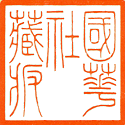
Publishing Company
Kazumasa Ogawa collotypes are also found in a magazine he published, Kokka, An Illustrated Monthly Journal of the Fine and Applied Arts of Japan and Other Eastern Countries. I have not determined how long Ogawa's work was featured in the Kokka. I suspect it was from the inception (October 1889) until approximately mid-1907. The last issue I have examined that specifically credited Kazumasa Ogawa collotypes is the May 1907 issue (No. 204). I have noted that once Kokka stopped attributing collotype plates to Ogawa, the descriptive text previously printed directly on the plate was no longer present.
The Kokka was published on a monthly basis. Vol. 1-28 (comprising nos. 1-337), Tokyo, 1889/91-1917/18 - the complete set through 1918 is said to contain over 2,000 plates (chromo-xylographs & collotypes). In general, the early issues through 1918 contain an average of 5+ plates per issue and generally 2 of them are color plates. Considered to be he oldest international art periodical from Japan, the magazine focused on the traditional Japanese and oriental art. Each issue has a number of articles, mostly by Japanese scholars, on Oriental art, history and architecture, with a strong emphasis on Buddhist art. Occasionally a special issue was published on a single topic covered by the plates and text. The Kokka has spanned four eras of Japanese history; Meiji, Taisho, Showa and Heisei. The 1st issue was published in October, 1889 and the 1,000th issue was published in August, 1991.
In addition to the black and white collotype plates, the magazine is noted for its color woodblock art reproduction prints. The color woodblock prints in the early years of publication are acknowledged as works of art of this fine woodblock printing technique. One unusual aspect of these prints is that they attempt to reproduce paintings and other art precisely as they existed at the time of production. They would reproduce flaws like dirt, smudges and damage (if there were any) just as it existed at the time the reproduction plate was prepared. The Kokka art reproductions are considered by many to be the most accurate and well created reproductions of fine Asian art.
The Kokka was published in the following formats from the inception through 1918:
- Nos. 1-132 (Volumes 1-11, 1890-1900), Japanese language only.
- Nos. 133-181 (Volumes 12-15, 1901 - June 1905), Japanese language and a Japanese language version with in brief explanation of the plates in English.
- Nos. 182-337 (Volumes 16-28, July 1905-1918), Japanese language and English language versions.
- Nos. 338 forward (Volume 29 on), Japanese language only.
In 1903 a catalogue of the Kokka was published which covered numbers 1-148 (October 1889 - September 1902). The catalogue contains a list in English of the painters and their works arranged according to schools and dates. This catalogue was supplemented for nos. 149-60 and nos. 161-170 and nos. 171-81.
The first 11 volumes (Nos. 1-132) sometimes have an insert in English only mentioning title and artist. In volumes 12 to 15 (Nos. 133-181) you sometimes (but not always) find explanatory text in English.
A unit running from 1-677 (October 1889 - August 1948) is said to have well over 2000 collotype and color woodblock plates.
Various formats of the publication exist. Two binding styles are noted: ribbon-tied and stitch-bound. Generally, the publication opens from right to left (ie back to front, Japanese style). During the period from 1905-1918 (volumes 16-28) an English version was stitch bound with gilt edges and assembled in the Western format reading left to right (ie front to back). The English and Japanese versions were not always identical in content.
Examples of the covers and color plates for two English language issues are here (No. 226, March 1909) and here (No. 233, October 1910).
In my experience, the issues from 1889 through 1904 are scarce. The English language editions during the 1905-1918 period are offered frequently by book sellers (unfortunately, quite often with the woodblock prints removed) but complete runs are hard to find. Complete runs, including the period from 1889-1918, are very seldom offered on the market and generally only available in library archives.
A typical Kokka issue in the early 1900s will contain the following:
Full page plates (generally 6):
- 2 color woodblock plates (with descriptive tissue guards), tipped in.
- 2 to 6 black and white collotype plates (by K. Ogawa)
- 0 to 4 black and white halftone plates
Text Illustrations - black and white halftone (generally 2-6)
Not all full page plates are collotypes or woodblocks, a few were printed in halftone.
The woodblocks were generally engraved by "S. Izumi" with "color press" by "T. Wada" or "T. Tamura."
Kokka issue 273, February 1913, contains a color plate that is described as "Chromoxylograph" (woodblock) with "collotype applied." This is an example of the mixed method printing process. To see an example, click here. More mixed method plates can be seen in Kodda issue 284, January 1914, issue 290, July 1919, issue 291, August 1914 (two such plates), issue 295, December 1915 and issue 297, February 1915. I have only examined scattered copies so these references are clearly incomplete. I believe that starting in 1913 (perhaps earlier), the publication began to shift from the pure woodblock method to the mixed woodblock and collotype method as the preferred method of printing the color plates.
As early as 1905 (probably much earlier), the Kokka was published by The Kokka Publishing Company, 10 Yazaemon-cho, Kyobashi-ku, Tokyo. The September, 1907 issue of Kokka has 3 collotypes and 2 chromo-xylographs. The collotypes are credited to Kazumasu Ogawa and topographical work is credited to the Tokyo Tsukiji Type Foundry. The company referred to it's monthly journal as "The Queen of Art Journals in the East."
For a sampling of seven issues between 1905 and 1907 (No 187//204) click here.
For more information on a 1907 issue (No. 208, September 1907), click here.
Kokka Issues Available.
~~ Available - Kokka, No. 226, March 1909 - Purchase Here ~~
~~ Available - Kokka, No. 233, October 1909 - Purchase Here ~~
In addition to the monthly journal, the company produced the following publications (based on advertisements found in Kokka).
- 1906, Jungo Murayama, Choice Masterpieces of Korin and Kenzan, Tokyo, The Kokka Company, topographical work by Tokyo Tsukiji Type Foundry, Meiji 39 (1906), folio (13 x 18 in - 33.3 x 45 cm), decorative cloth covered boards, 10 color woodblock prints tipped to thick card stock plates, decorative end-papers. One woodblock spans two plates. The numbered text pages include biographical information on Korin and Kenzan and a one paragraph discussion for each of the 10 plates depicting art by of these two artists. Each plate is protected by a descriptive tissue guard with information in English and Japanese. New issue price 10 yen. For more information on this book, click here.
~~ Available - Masterpieces of Korin and Kenzan - Purchase Here ~~
- ca 1907, Masterpieces of Thirty Great Painters of Japan (Honcho San-ju-ku Meiga-shu), ca 1907, folio, First Edition, 19 woodcut engravings, 31 black and white collotype plates, text in English and Japanese, bound in silk, new issue price was 25 yen.
- ca 1907, Hokusai's "Nisshin Jomajo" (Daily Exorcisms), ca 1907, folio, billed as "Latest Discovery of Hokusai's once-thought lost sketches." Bound in cloth. New issue price was 8.5 yen.
- 1907, Masterpieces of Thirty Great Painters of Japan (Honcho San-ju-ku Meiga-shu), Tokyo, Second Edition, folio, 18 woodcut engravings, 32 black and white collotype plates.
- 1908, Jungo Murayama, A Gallery of Japanese and Chinese Paintings, The Kokka Company, topographical work by Tokyo Tsukiji Type Foundry, folio (17 x 12 in), 100 plates (72 in black and white collotype and 28 tipped in color woodblock prints), gold and green brocade silk over boards, string tied. New issue price was 48 yen. For more information on this book, click here.
~~ Available - Japanese and Chinese Paintings - Purchase Here ~~
- c1910, Art Treasures of the Koyasan Temples, 37 plates (30 black and white collotype and 1 color woodblock print). Reproductions of art from the Kongobu-ji temple and other "seats of worship" on mount Koya. New issue price 15 yen.
- Print Folios. You sometimes find folios with the Kokka imprint. These folios generally contain 10 loose color woodblock prints inside a folding cases.
- Plates for Brinkley Sets. The Kokkwa Publishing Company (Kokka) also produced the color woodblock art reproduction plates found at the back of the deluxe edition sets of the 1897-8 ten volume Brinkley sets, Japan Described and Illustrated. Kakuzo (aka Tenshin) Okakura, a famous Japanese scholar who contributed the development of arts in Japan, was associated with the Kokka. He also provided essays on Japanese art which were published in the deluxe edition volumes of the Brinkley set along with the Kokka produced color woodblock plates.
Kazumasa Ogawa's Autobiography.
- 1927-1928, Ogawa Kazumasa, 7 part series of articles titled "Ogawa Kazumasa o: keirekidan" [Venerable Mr. Ogawa Kazumasa: a personal history], published in Asahi Kamera, Tokyo, Asahi Shinbunsha, 1927-1928. Parts 1-7 are October (1), November (2), December (3), 1927; and January (4), February (5), April (6) and July (7), 1928 (information on this autobiography courtesy of Olivier Krischer).
Articles on Kazumasa Ogawa.
- 1890, March 22, issue of Anthony's Photographic Bulletin, W.K. Burton article, pages 181-5.
- 1894, June 1, issue of Practical Photographer, "K. Ogawa," article by W.K. Burton. Three collotype plate images are reproduced in the article.
- 1895, February 22, The Photographic News, "Photo-Mechanical Work in Japan," article by W.K. at pages 118-19.
- 1902, Anthony's Photographic Bulletin (Volume 33), pages 86-7.
- 2017, Trans Asia Photography Review, Volume 7, Issue 2, Technologies, Spring 2017, published by Hampshire College (Amherst, MA) in collaboration with Michigan publishing. Journal article titled "Ogawa Kazumasa and the Halftone Photograph: Japanese War Albums at the Turn of the Twentieth Century." An indepth journal article on K. Ogawa's career with special emphasis on the halftone photographs in his Japanese War albums. Article is here.
For information on basic reference books that deal with photography in Meiji era Japan, click here.
Japanese Language Addresses Related to K. Ogawa:
Ogawa Portrait Studio
Gyokujunkan, Tokyu (1885)
Ogawa Kazumasa Photographic Copperplate Engraving Studio
(Ogawa Kazumasa Shashin Seihanjo or
Ogawa Kazumasa shashin chokoku dobanjo)
Tokyo 1889
Ogawa Kazumasa (Isshin)
Tokyo Address 1892
(Perhaps since 1885 when he opened his Tokyo Studio)
Tokyo, Iidamachi No. 4, Shichome, Kojimachi-ku

Ogawa Kazumasa (Isshin)
Tokyo Address 1894~1896
Also Ogawa Shashin Seihanjo
[Ogawa Photoengraving Company/Factory] until 1894
Tokyo, Hiyoshi Cho, Kyo Bashi

In early 1894 Ogawa returned from the United States
with equipment for producing halftone images and
probably initially operated from the above facility.
Ogawa Kazumasa (Isshin)
Tokyo Address, Mid 1895
Varies Slightly from Above
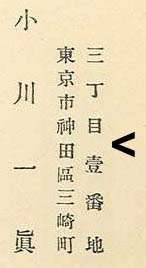
Found in Book w/ Collotypes Illustrations
Ogawa Kazumasa (Isshin)
Tokyo Address 1896
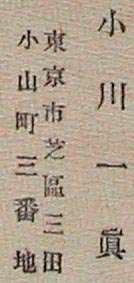
(Illustrations of Japanese Life, 1st Ed)
Ogawa Kazumasa (Isshin)
Tokyo Address 1897
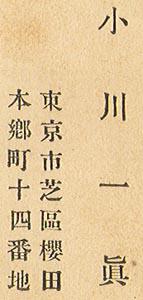
Ogawa Kazumasa (Isshin)
Tokyo Address, 1898~1911
13 Hiyoshi-cho
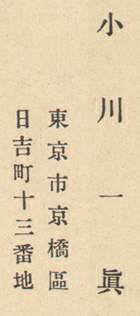
Ogawa Shashin Seihanjo (Seihan Sho)
[Ogawa Photoengraving Company/Factory]
(1894-1913, Tokyo Address on Left)
13 Hiyoshi-cho, Tokyo
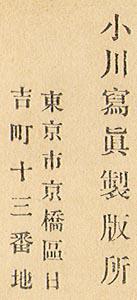
Note this address omits Kazumasa (Isshin)
Ogawa Shashin Seihanjo (Seihan Sho)
(1896, Tokyo Address)
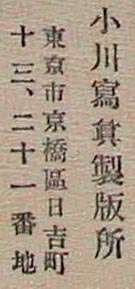
(Illustrations of Japanese Life, 1st Ed)
Ogawa Kazumasa (Isshin) Shashin Seihanjo (Seihan Sho)
[Ogawa Kazumasa (Isshin) Photoengraving Company/Factory]
(1896, No address specified)

Ogawa Kazumasa (Isshin)
Photographic Studio
K. Ogawa's Photo-Studio, No 13 Hiyoshi-Chio
Collotype and Half-tone Prints (photo-engraving)

To see a 1904 advertisement for the
K. Ogawa's Photo-Studio, 13 Hiyoshio-Chio,
Tokyo, click here.
Ogawa Kazumasa (Isshin)
Tokyo Address 1906
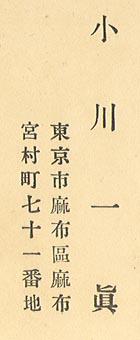
Ogawa Kazumasa (Isshin) Shuppanbu
[Ogawa Distribution Center]
(Tokyo, 1906)
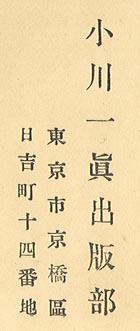
Example of 1906 Colophon where K. Ogawa
is the Publisher, Printer and Distributor
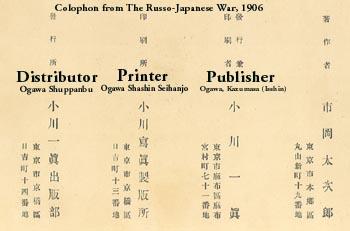
K. Ogawa's Photogravure Depot
1918-1919 ~ 13 Hiyoshi-cho, Tokyo

Photogravure Depot stated only in English on the title page.
While designated "Photogravure" all plates I have examined
are collotypes.
Miscellaneous Image
Printing Processes
Collotypes.
- Basic Information. Collotype printing is a very high quality process that allows an extremely precise reproduction of tones. This process is best known for the ability to produce a full range of tones without relying on dots. Under magnification there is no evidence of a mechanical process such as a grid pattern, screen or dots. Instead, you see a texture with numerous fine curving irregular shaped lines. This type of pattern is known as reticulation. The collotype process is a very versatile process which can be executed on a variety of presses including letterpress, intaglio and lithographic. The collotype process was pioneered in Japan by Kazumasa Ogawa in the 1890s and, though it accounted for a relatively small amount of printing output, it immediately became highly respected as the printing method that produced the highest quality reproductions. This process was widely recognized as the premier method for reproducing art for publications and was used when a publisher required high quality photo-mechanical reproduction of photographs.
This is a photo-mechanical process where gelatin is applied to a glass plate which is allowed to dry and then exposed to a photographic negative. Once exposed, a fine grained image is created on the reticulated gelatin. The exposed plate can be used to print onto paper. The fragile gelatin surface and glass plate limit the number of impressions that can be made. In a collotype image the detail is reticulated and appears like a mosaic with similar size pieces of irregular shapes. The size of the reticulation varies from print to print but cannot be seen by the naked eye. This process was invented in 1855 by Alphonse Poitevin and was immensely popular in Japan from the 1890's to the 1920's. Because of the high cost of copper associated with gravure printing, collotype became Japan's preferred method of printing over the gravure process. This process was recognized as a superb method of producing black and white and color images. However, it was an expensive labor intensive process and not suitable for high volume printing requirements. For many printing applications, it was replaced by the much lower quality off-set process beginning in the 1910s. However, for limited and high quality printing requirements, the process was commercially viable as late as the 1990s.
- Color Collotypes.
- Printed in Color (Multi-pass Process). These prints were created mechanically by a process said to be parallel to that used in chromolithographs. They are sometimes called chromo-collotypes and Ogawa even used the term chromo-collotype on the title page of some of his books. The famed K. Ogawa flower collotypes found in the Brinkley books are color collotypes created by the multi-pass process.
The publisher, J. B. Millet, described them this way:
There are 15 collotypes [A collotype is a kind of photo-lithograph in which glass replaces stone as the printing surface] of Japanese flowers produced by a process that could not be duplicated outside Japan. The colors used and mounting methods are most impressive. 15 to 25 colors were used in a single picture and each print passed through a press for each shade.
We are indeed fortunate that Professor W. K. Burton, an expert in photography and printing, lived in Japan and was a friend of K. Ogawa. In February 22, 1895 in The Photographic News, Burton described the color collotype process, which he called "chromo-collotype," then used by K. Ogawa this way:
First, an ordinary collotype is made, and this is handed to an artist, who colours it, using whatever may be the fewest pigments that he considers necessary to produce the effect that he aims at. An average number is about eight, but sometimes as many as twelve are used.
The single copy having been coloured, a number of copies are taken corresponding to the number of pigments that have been used, and each of these is coloured by the same artist with the same one pigment, in the parts corresponding with those to which the same pigment was used in colouring the first collotype. These pigments are all of the nature of transfer ink, and a transfer is made from each to a lithographic stone.
The transfers having been made, the collotypes are passed over the stones, each imprinted with one particular tint only, the number amounting to anything up to twelve. (The Photographic News, "Photo-Mechanical Work in Japan," February 22, 1895, Professor W.K. Burton, at page 118).
The process described by Burton appears to be a merger of the collotype process with the chromolithograph process.
In an article published in Anthony's Photographic Bulletin, Volume XXVI, in 1895, Burton discusses all the printing techniques employed by Ogawa (black and white collotype, chromocollotye and Meisenbach photo-engraving process). To read this discussion, click here.
I note that the Millet description, above, is somewhat at odds with Burton's description. However, I suspect Burton's description is more accurate when it comes to K. Ogawa's work.
It appears that the common practice for making color collotypes was different, and much simpler, than the process employed by K. Ogawa. In his book, The Practice of Collotype (1935, Boston), Thomas A. Wilson, describes the three color collotype process. In the simplest form, the process employed three different color separation negatives (yellow, red, green). A separate collotype plate would be made from each negative and then the collotypes would be printed by applying these plates in sequence (yellow, red, green). Wilson alludes to the process employed by K. Ogawa in these terms:
A method by which some beautiful prints have been produced is to make one or two of the printings from collotype plates, the picture being completed by an impression from a hand-drawn lithographic stone. In skillful hands, this method is really a fine art. (Wilson, page 83)
- Handcolored. Just as with albumen photographs, collotypes were often handcolored. This was a common practice in Japan in the late 19th century and very early 20th century. In my experience, this was the primary process used to add color to these items in the Meiji era in Japan. You often find these compiled in albums for sale in the tourist trade. A more efficient and consistent method of hand coloring involved creating stencils for the colors to be used and then applying the colors over these stencils. Plates created by this method are referred to as hand-stencilled color collotype.
- Other Terms for the Process. Black and white collotypes are often designated as: Albertype, artotype, autogravure, autotype, heliotype, hygrotype, photogelatine, phototype, photolithographie and phototint. The color collotype process was named after its inventor and often called Hoeschotype.
Color Woodblock Processes.
- Color Woodcut. The woodblocks used to create the various colors are cut on the plank surface of the woodblock. Generally one block is cut for each color. A simple color woodcut (woodblock) would employ up to nine blocks. These prints are characterized by broad patches of color. Generally original art work was created with this process.
- Chromoxylograph (color from wood). The woodblocks used to create the various colors of a chromoxylograph are engraved/cut on the end grain of the woodblock. This makes it possible to break up the colors into more intricate patterns of finely engraved hatching. These prints have more intricate overlapping patterns. This process, because of the fine detail it allowed, was found to be a very useful method for reproducing art. The Shimbi Shoin was a leader in using this printing technique in the early 20th century. To see how they described the process, click here. You sometimes see this term used for a woodblock print, without a distinction, as to where the blocks were created from the plank or the edge surface. However, it seems to generally be applied to the finer prints created using the end grain of the woodblock.
Mixed Methods. While I don't find it to be a common practice, some Meiji Japan era art reproductions were a created by a merger of the collotype and chromoxylograph processes. The basic image was created in a collotype print and then layers of color were added by the woodblock print process. To see an example, click here.
Photochemical (Photo-mechanical), Halftone Processes. In technical terms photo mechanical is another term for photo-chemical (combination of photography and chemistry). In the 1880s the primary photo mechanical processes were gravure, relief halftone, halftone offset lithography and metzograph screen.
- Photogravure Printing. A mechanical printing process that produces images of high quality and definition but not as fine as the collotype images. This printing is characterized (under magnification) by an extremely fine grid screen (white line grid pattern) of soft ragged square ink pits. The individual cells are of similar but not uniform sizes. This process entered widespread use in the 1890s. Unfortunately, the cell pattern is often very hard to detect. If an image in a 1880 to early 1900s publication is high quality with no dots and no fine curving irregular shaped lines (reticulation), it is probably a photogravure. The appearance of a photogravure has been compared to "confectioner's sugar." These images will be printed on thicker paper (mat) and accompanied by a protective sheet (tissue guard). To see an example of a photogravure image, click here. It should be noted that the photogravure process was not the favored process in Japan. Instead, the collotype process as first established by K. Ogawa, and later employed by the Benrido Company in Kyoto, was the premier photo-mechanical printing process.
- Relief Halftone Printing (photo-engraving) (letterpress). A less expensive mechanical printing process know as relief halftone was perfected in the 1870s and came into widespread use in the 1880s. In this process, the photographic image is recorded on a sensitized metal plate which is then etched in an acid bath. The halftone effect is accomplished by projecting the image through a wire or glass screen, which breaks the light rays so that the metal plate is sensitized in a dotted pattern; the larger dots create the darker areas, the smaller dots the high lights. The finer the screen, the greater the precision of detail in the printed product. The printed images lack the definition provided by photographs or the collotype process. A a photo-engraved relief halftone image is easy to identify. When you look at the image under even light magnification (x5 or x10) you see the series of dots with clean edges that make up the image. To see an example of four color relief halftone printed in Japan ca 1933, click here.
It appears that ca 1894, Ogawa began printing plates using the conventional relief halftone printing method. You find the The Japan - China War (info here) printed in collotype and "photo-engraving" (relief halftone) formats. To see the difference in the plates click on the image below.
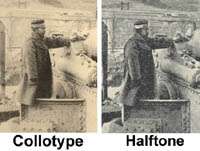
- Meisenbach Process Halftones. During the 1890s K. Ogawa was producing very high quality half tone impressions in addition to his collotype plates. In February 22, 1895 in The Photographic News, W. K. Burton discussed Ogawa's "photo-engraving" activities. He discussed the process this way.
The process worked is that generally coupled with the name of Meisenbach. That is to say, it is a process with a fine cross-line screen. The screens, 12 by 10 in size with lines spaced from 80 to 135 to the inch, are the well know diamond cut screens of Levy. They are the first of the kind that I have seen and are certainly most exquisite pieces of work, vastly superior to photographically prepared screens that I have seen and used. (The Photographic News, "Photo-Mechanical Work in Japan," February 22, 1895, Professor W.K. Burton, at pages 118-19).
Mr. Burton provided additional details in an article in Anthony's Photographic Bulletin, Volume XXVI, 1895 which stated:
Mr. Ogawa's photo-engraving works contain collotype machines worked by hand; he also has machines driven by steam for photoengraving work. He uses the Meisenbach process, and obtains grain by the employment of the diamond-cut screens made by Levy. He finds a distance of one-fifth of an inch, including the thickness of the cover-glass of the screen, to be about the best distance for average work between the screen and the plate; he most commonly uses a diaphragm of about 1 inch square, with a lens of 13 inches focal length; the less the contrast in the original, the greater should be the distance between the screen and the plate. The greater the distance between the lens and the plate, the larger should be the diaphragm. The chemical process used is one which has been sold in Europe and America as a secret one, which had been bought by Mr. Ogawa, so Mr. Burton asked him no questions in relation thereto, and described alone what he saw, from which it appears to be the fish-glue process. Ogawa's re-etching is done by applying the etching fluid with a fine hair pencil to those parts of the plate which have to be deepened. Plates are made for the trade by Mr. Ogawa at a rate corresponding to about 6d. per square inch. He turns out prints of about cabinet size at the rate of more than two hundred for a penny, if he gets a large enough order and the paper is supplied to him; in such cases, however, six different pictures are etched upon one plate, or six small plates are fixed to the bed of the machine. (Anthony's Photographic Bulletin, "Photo-Mechanical Printing in Japan," Volume XXVI, Professor W.K. Burton, at pages 86-7, entire article is here).
Burton also noted that Ogawa's negatives were made on collodion (wet plates) rather than dry plates. Copper plates coated with chemicals were then exposed to the negatives and the printing plates created. Burton notes that Ogawa made plates 'for the trade' and also could produce up to 6,000 impressions an hour on his four in house machines. At the time the article was written, Ogawa was involved in making half tone impressions of pictures of the Sino-Japanese war and was producing 100,000 impressions a day according to Burton. To see a close up example of this process from Ayame-san (Ogawa, 1892), click here. This book appears to be the first one produced by Ogawa with halftone images. The images in this book are very high quality and appear to be more like collotypes than halftones. I believe that in the 20th century Ogawa ceased using the higher quality Mesienbach process and started producing the lower quality halftones.
To see the difference in the plates in collotype, halftone mesinbach process and halftone conventional process click on the image below.
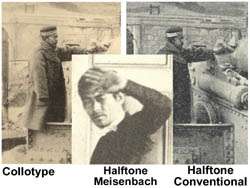
- Offset Printing (offset lithography). In 1906 the offset printing press was invented. This mechanical process provided an efficient and economical method of high volume printing, particularly color printing. While color offset printing was no doubt introduced into Japan shortly after its invention, it was in common use by 1918. The best way to distinguish it from gravure and half-tone printing is by examining the dot pattern under magnification (x10 ~ x30). In gravure printing the dots, while of different intensity, are aligned in a white line grid pattern and they are similar in size. In half-tone and offset printing you do not find this white grid line pattern. In half-tone printing (letter press) the dots have clean edges and where they merge they often form a rim. In offset printing/offset lithography in pale areas where the dots remain separate the edges are blurred. In the darker areas no dots will be evident.
The picture below is from a offset color lithograph in the book Tokaido: Hiroshige-ga Gojusan-tsugi
Genjo Shashin Taisho (info on the book is here).
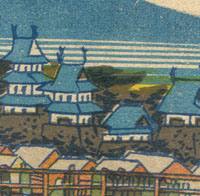
Color Offset Lithograph
Note Regarding
Japanese Copyright Law
See National Diet Library Newsletter (No. 134, December 2003). Information can be found here. The Newsletter summarizes the Japanese copyright law as follows:
Copyright continues to exist until the end of a period of fifty years following the death of the author (Article 51). As for the duration of copyright, there are some exceptions for anonymous and pseudonymous works, the works of a legal person or other corporate body, and foreign authors. However, the basic assumption on general works is that from fifty-one years after the death of the author, the work is free from the copyright.
|
